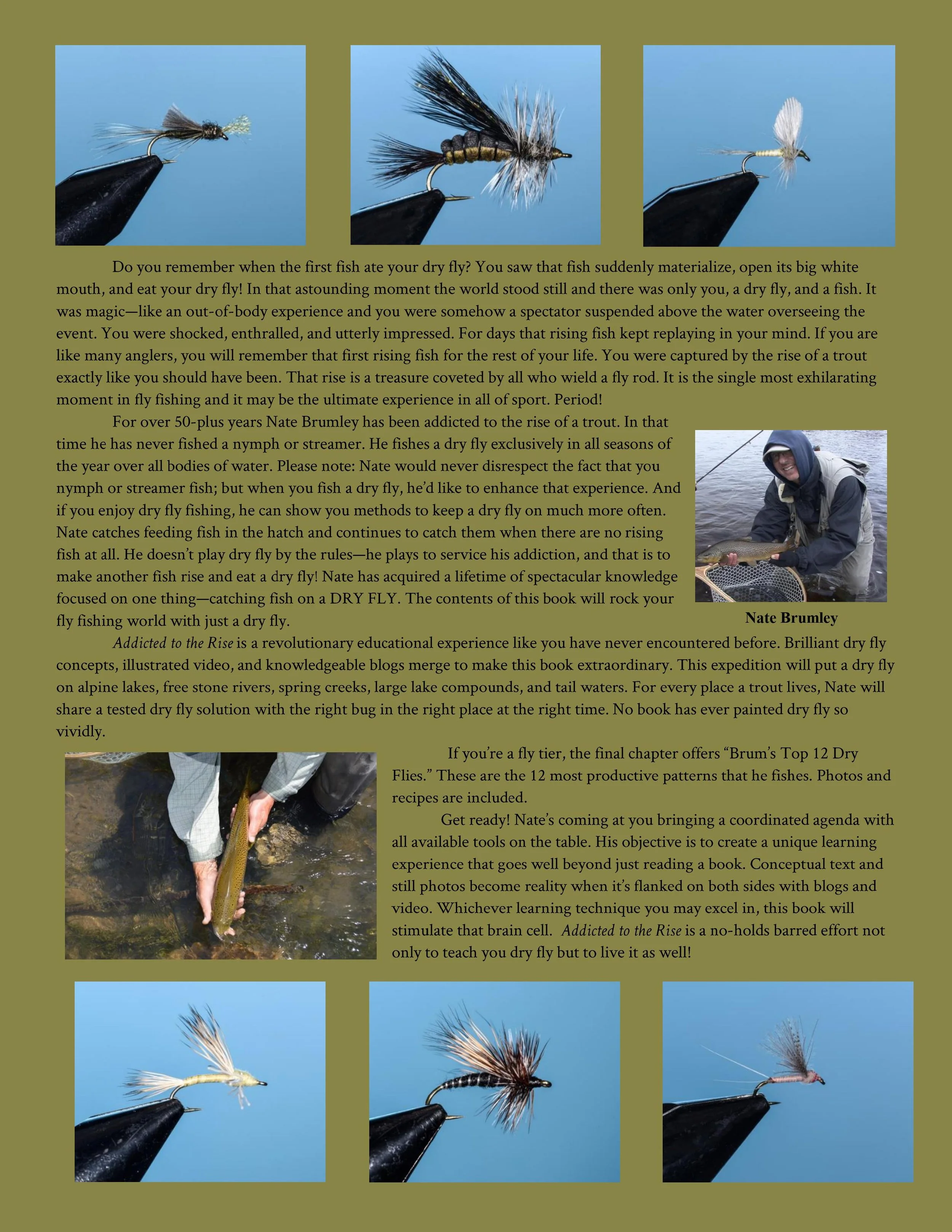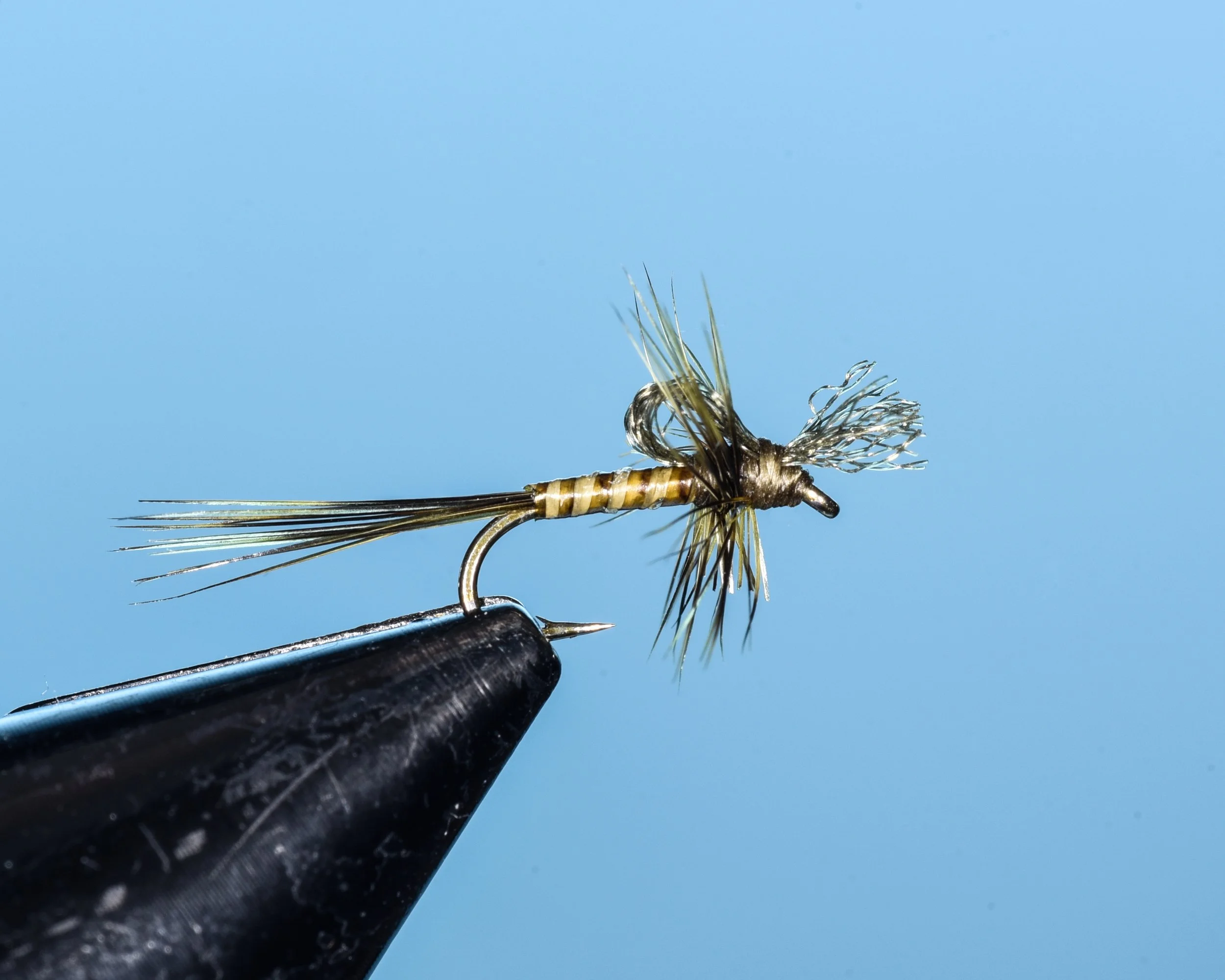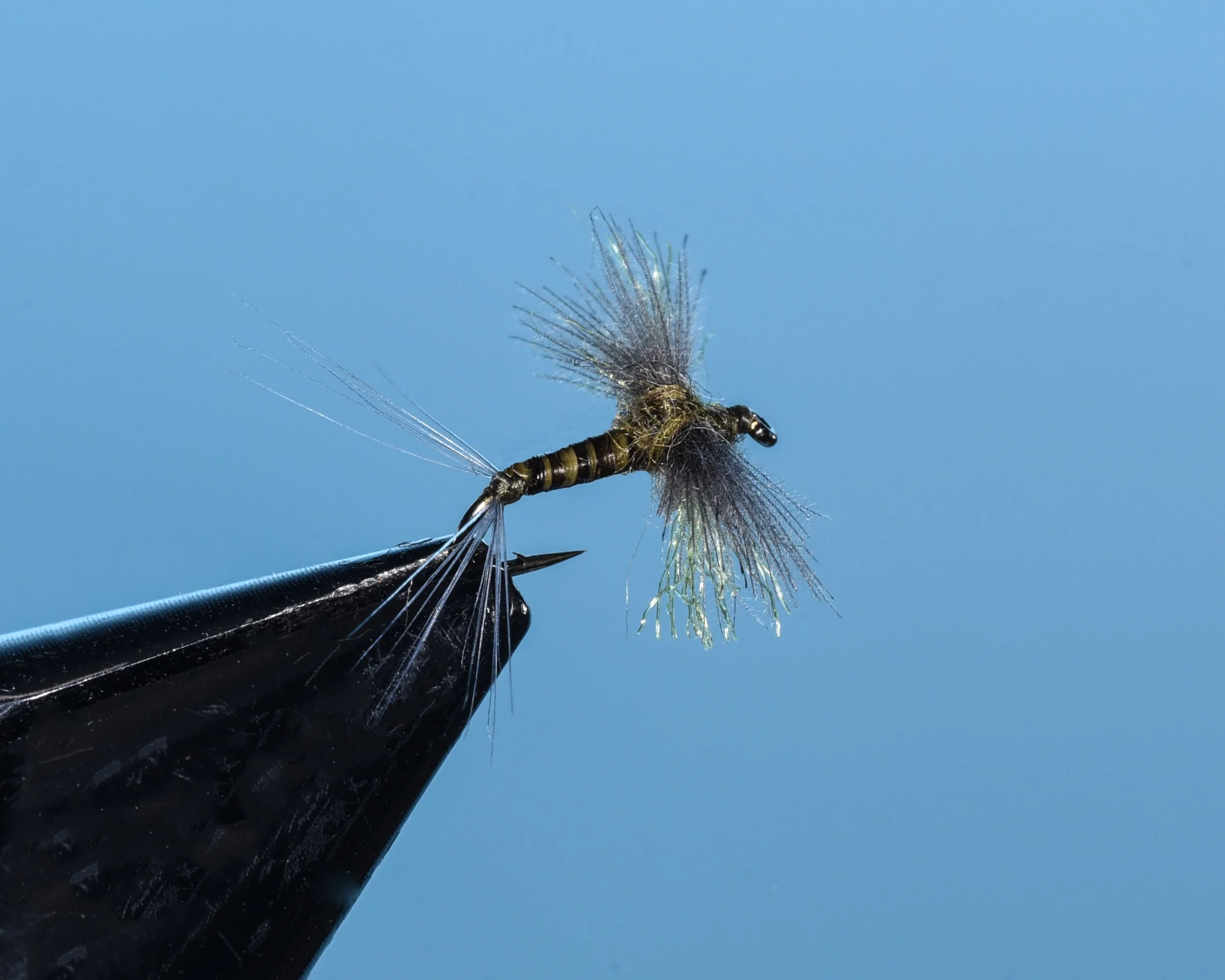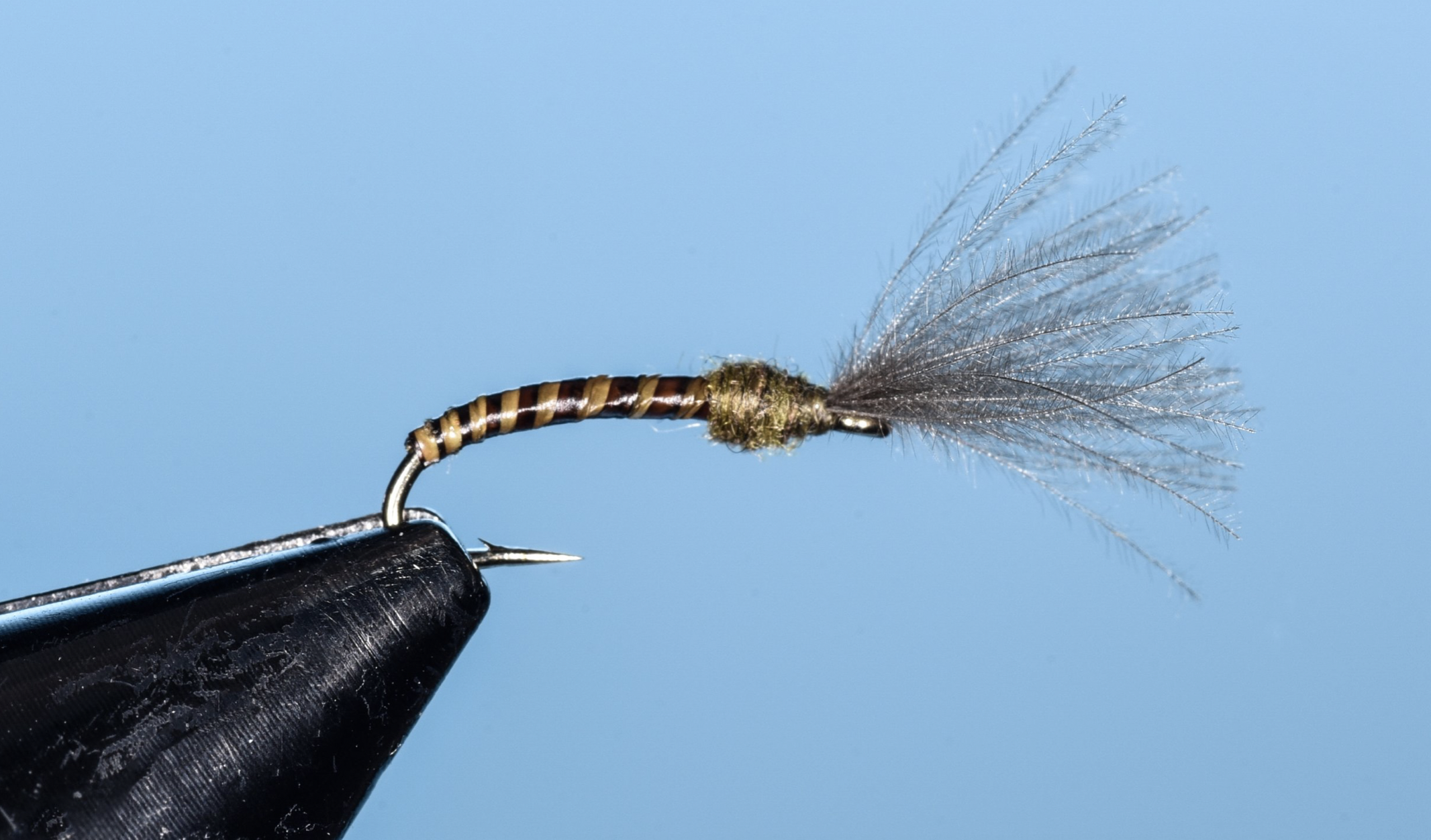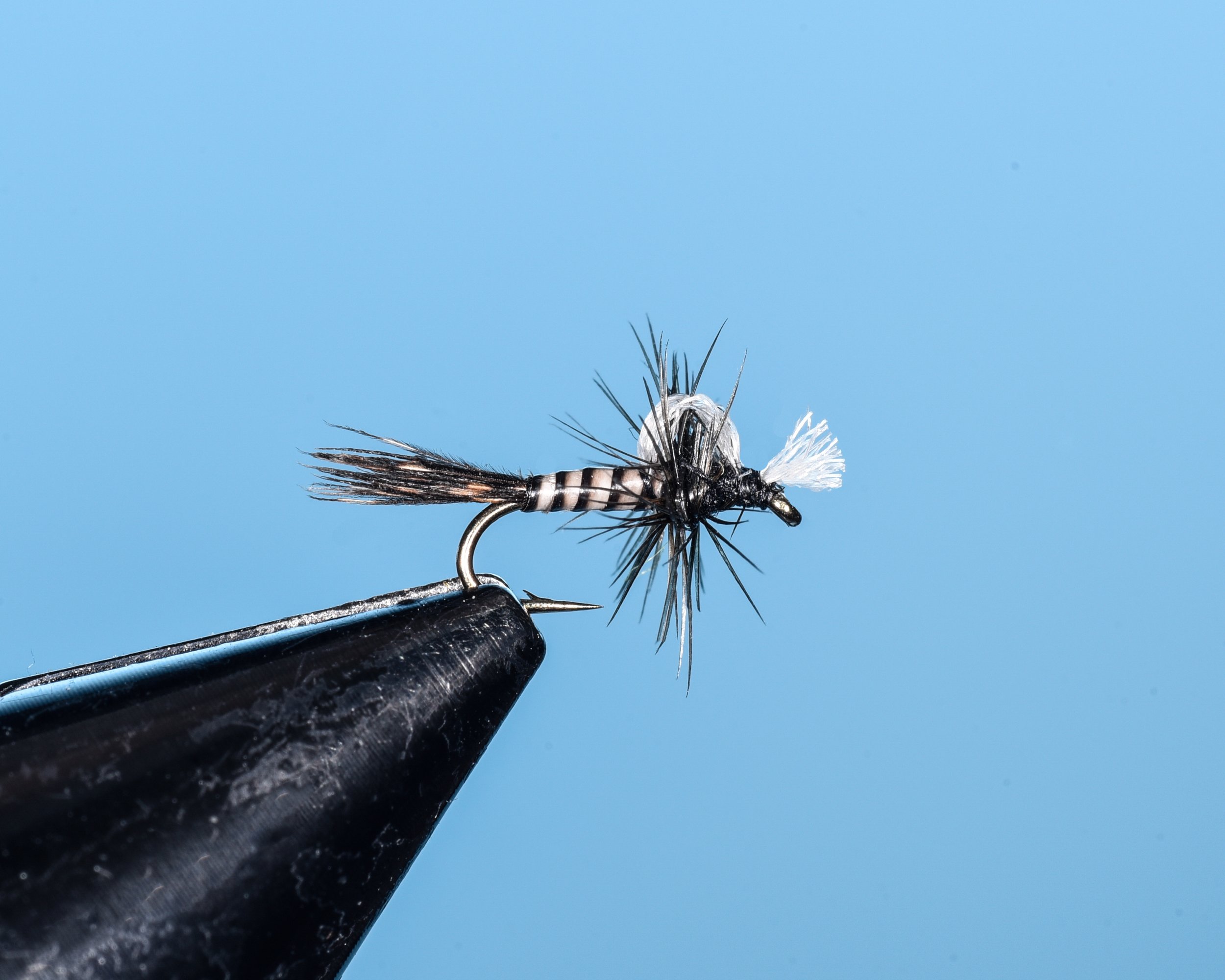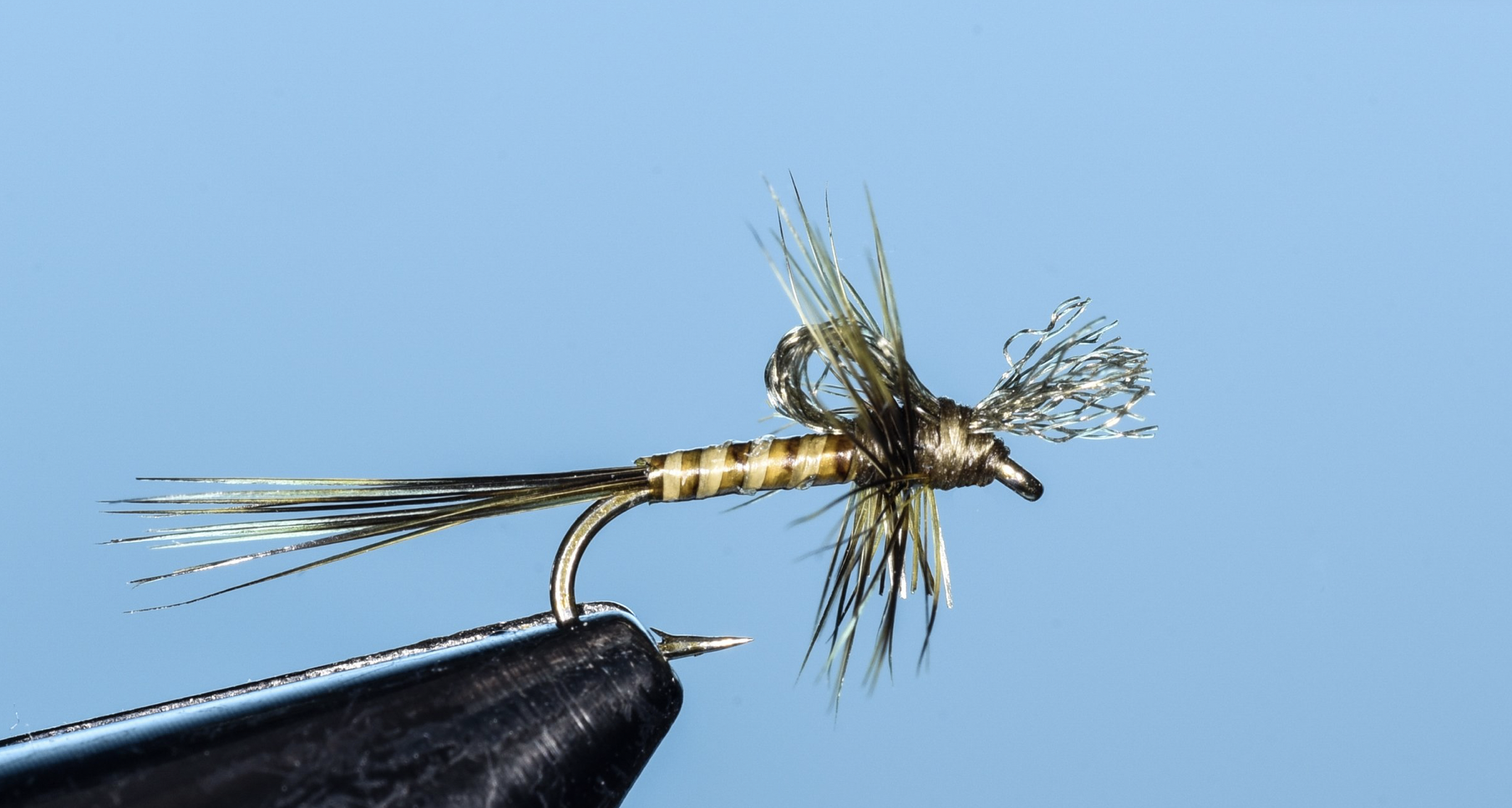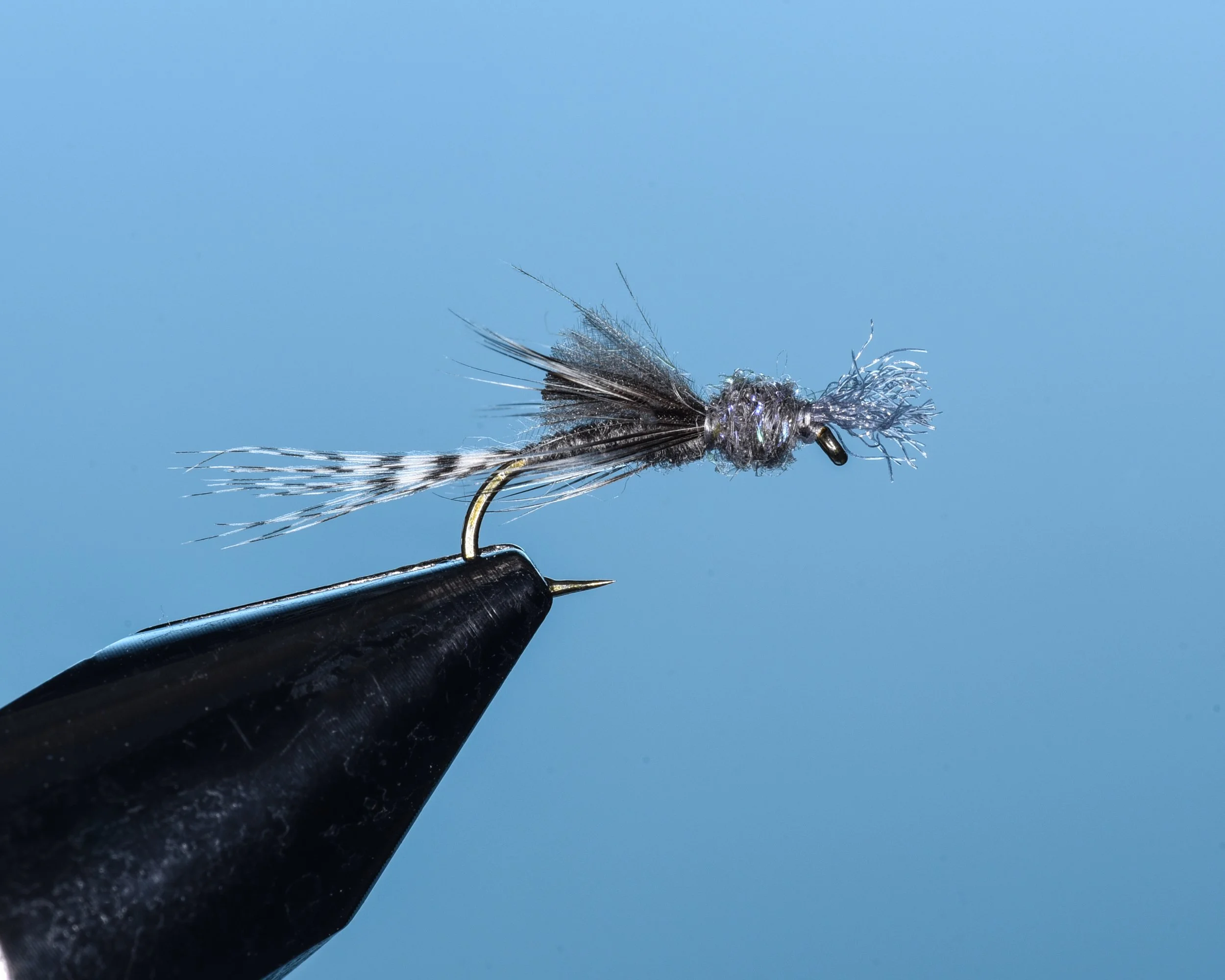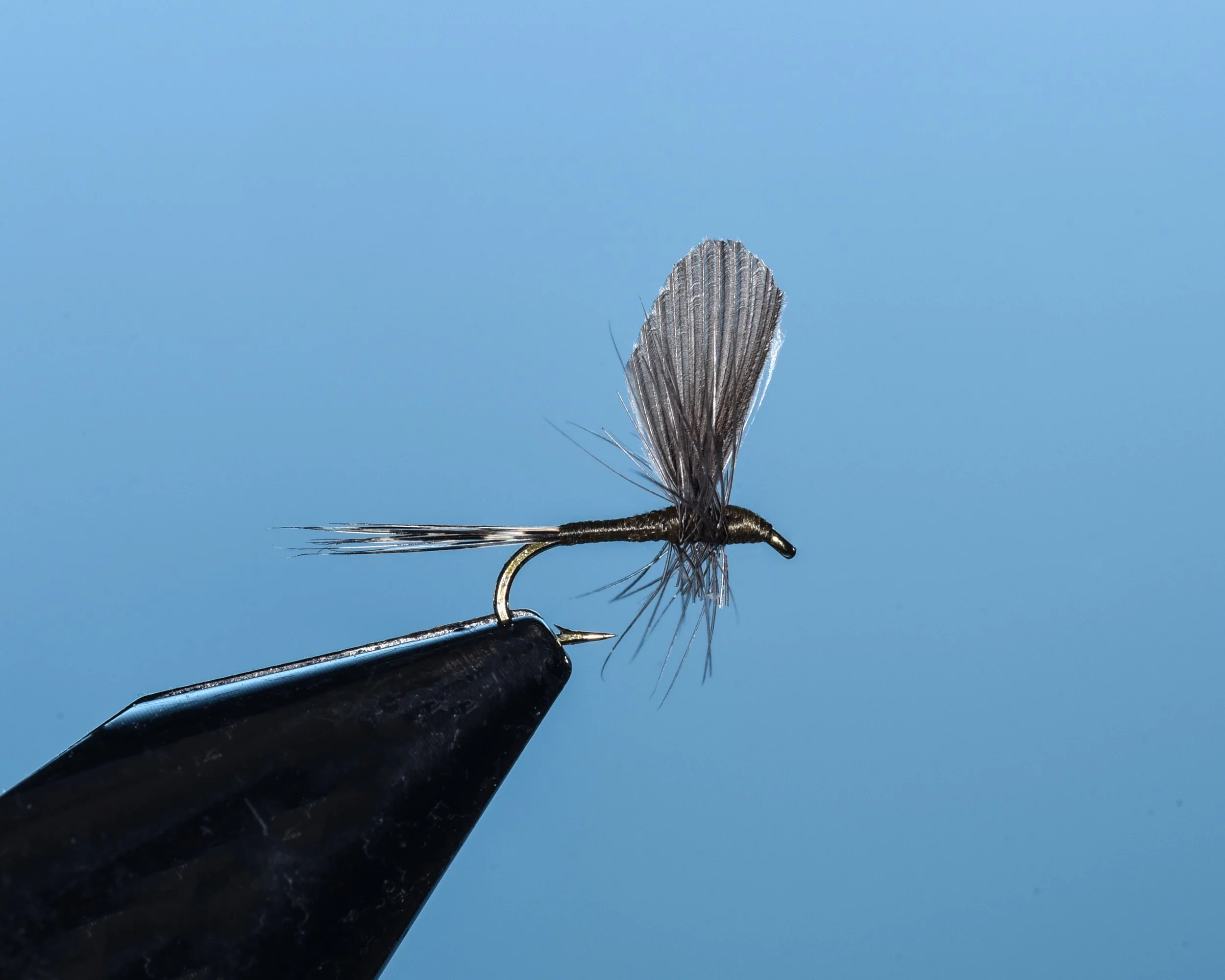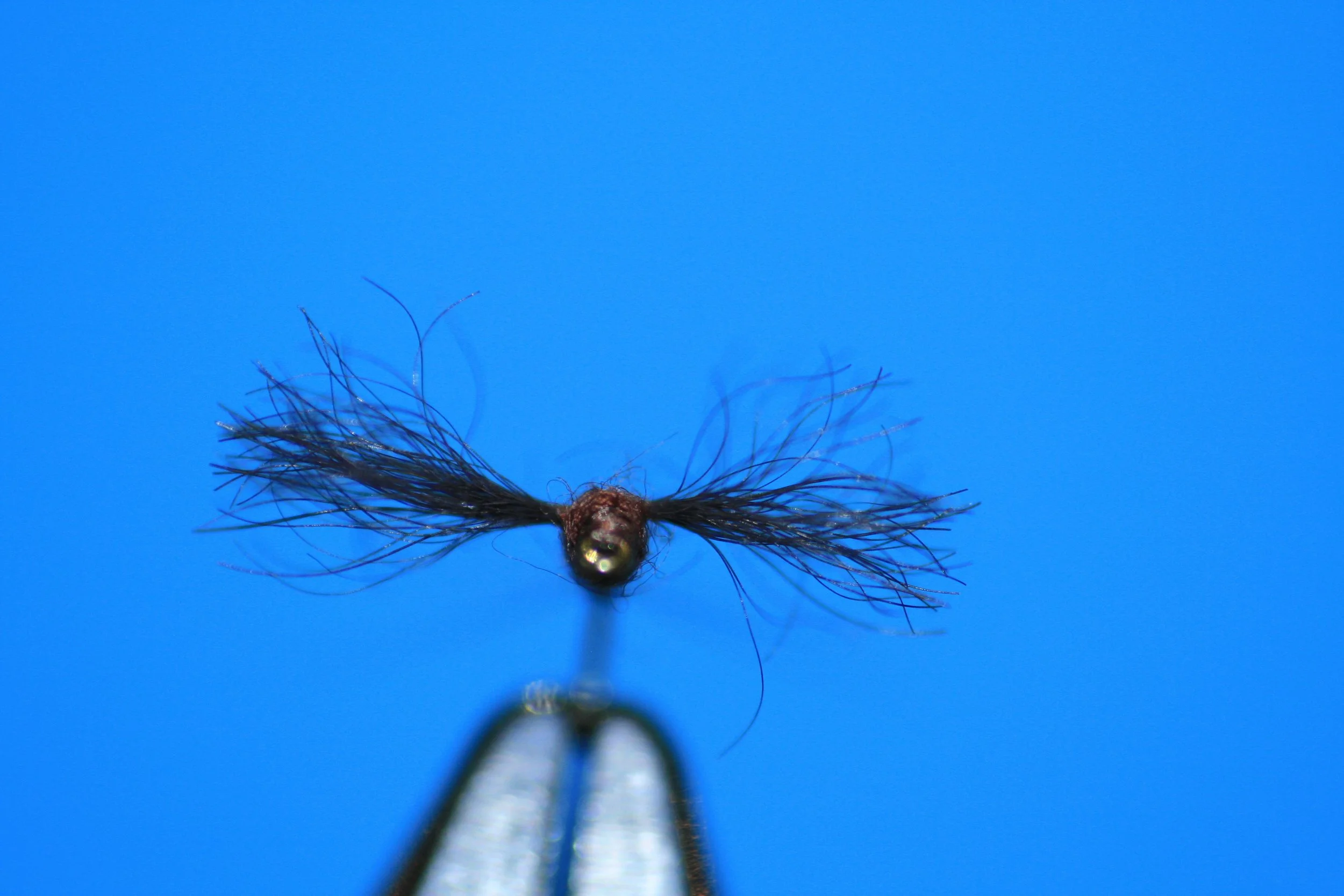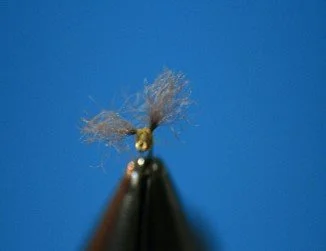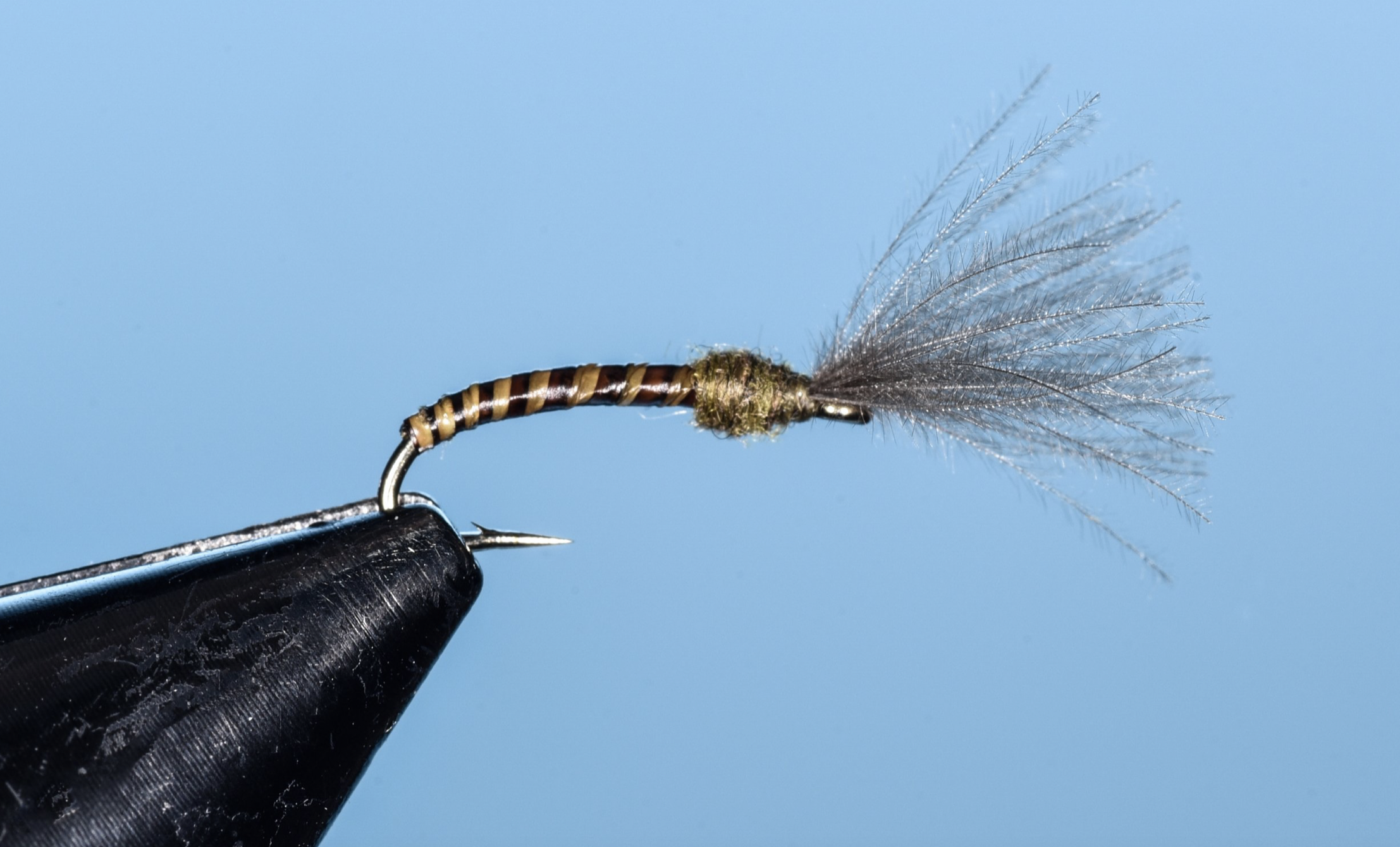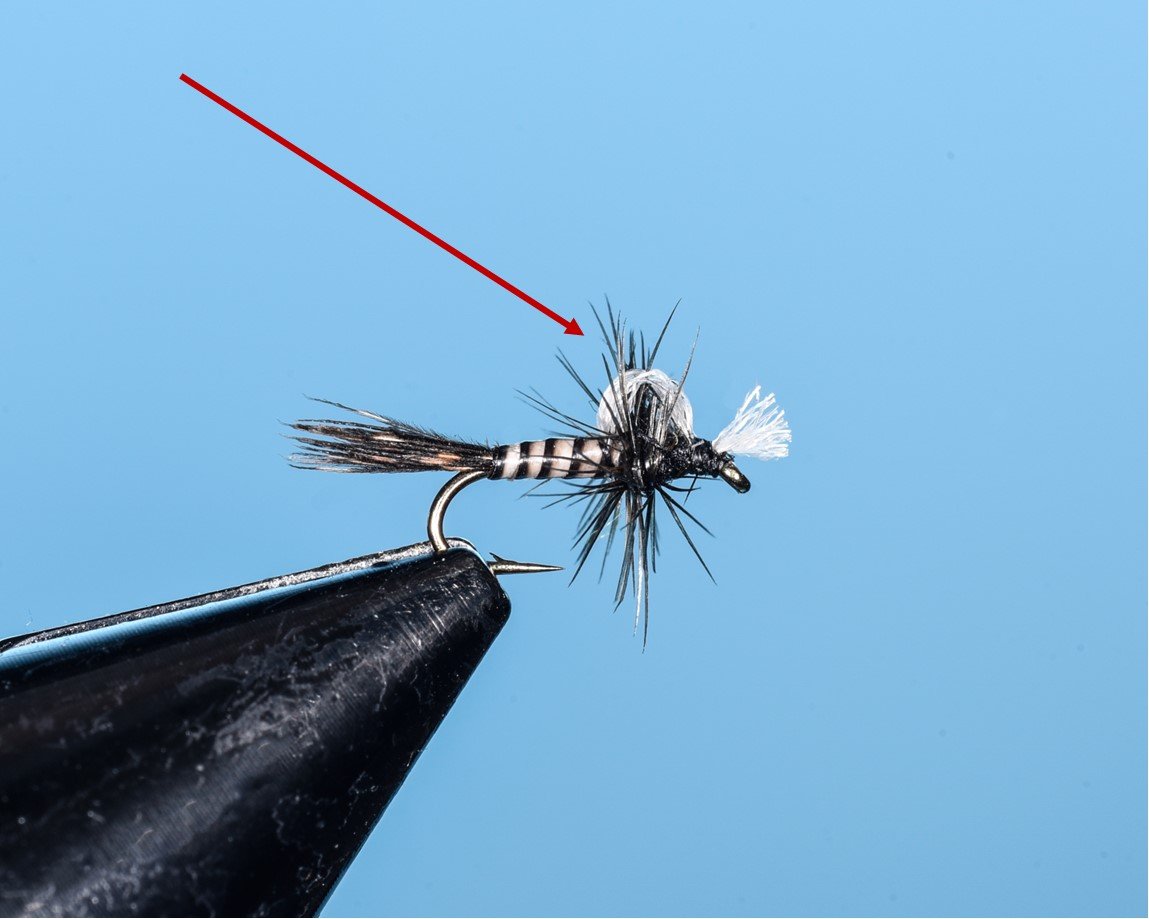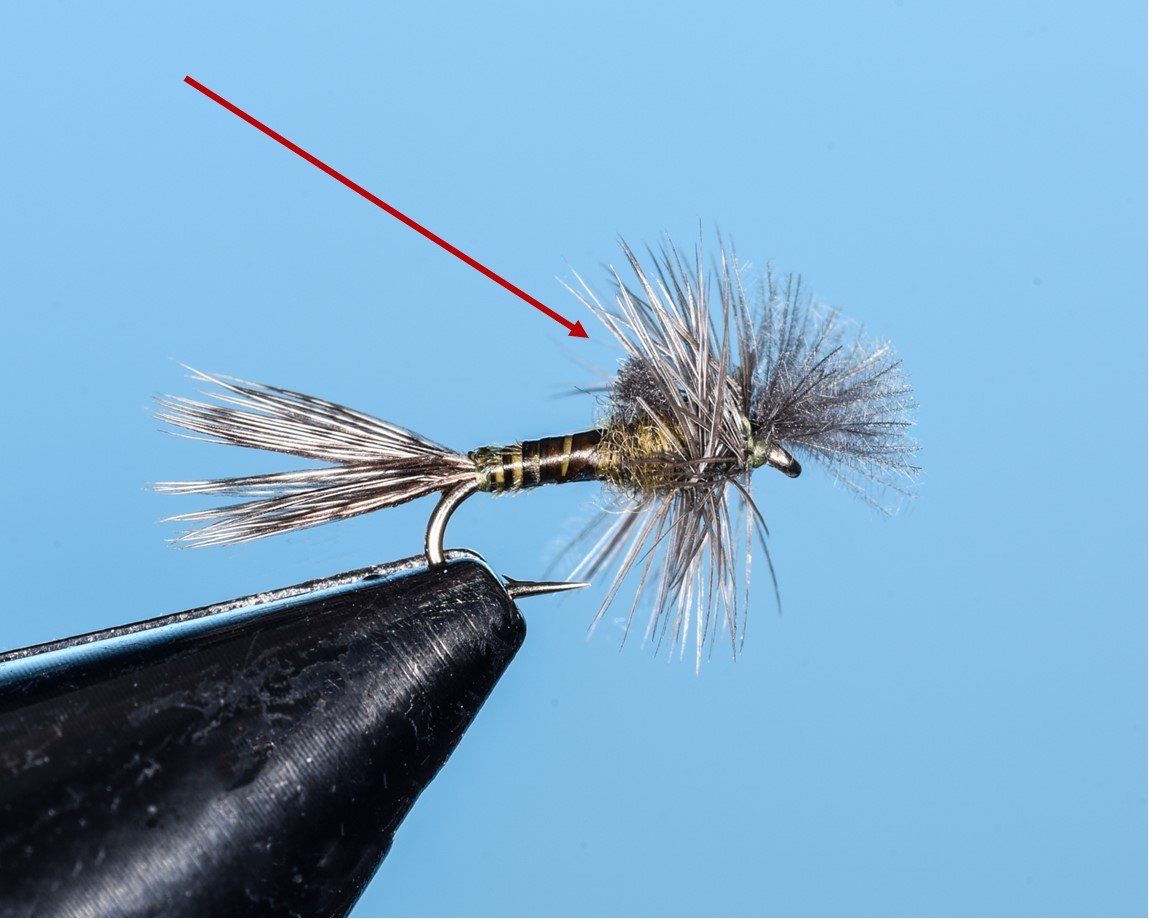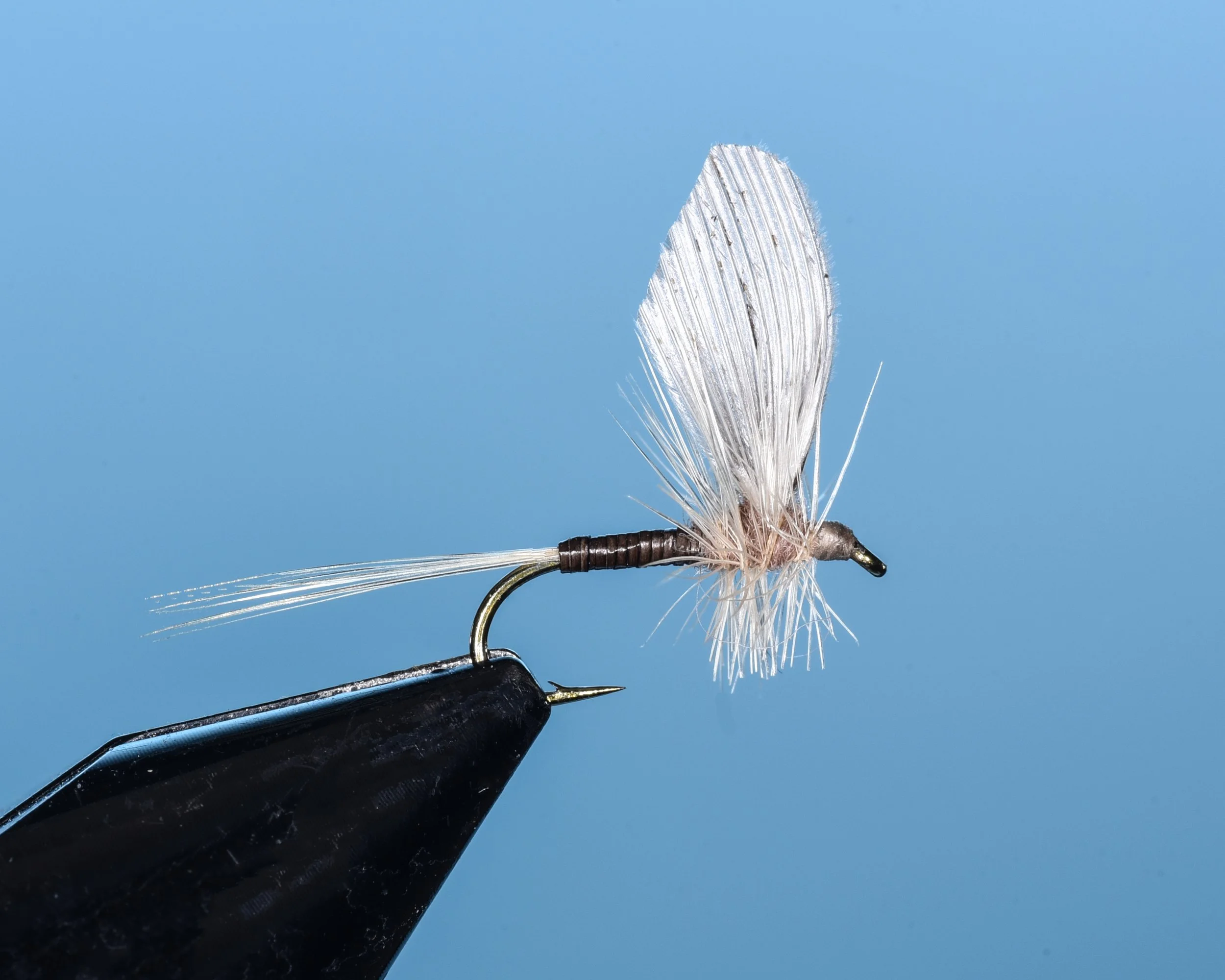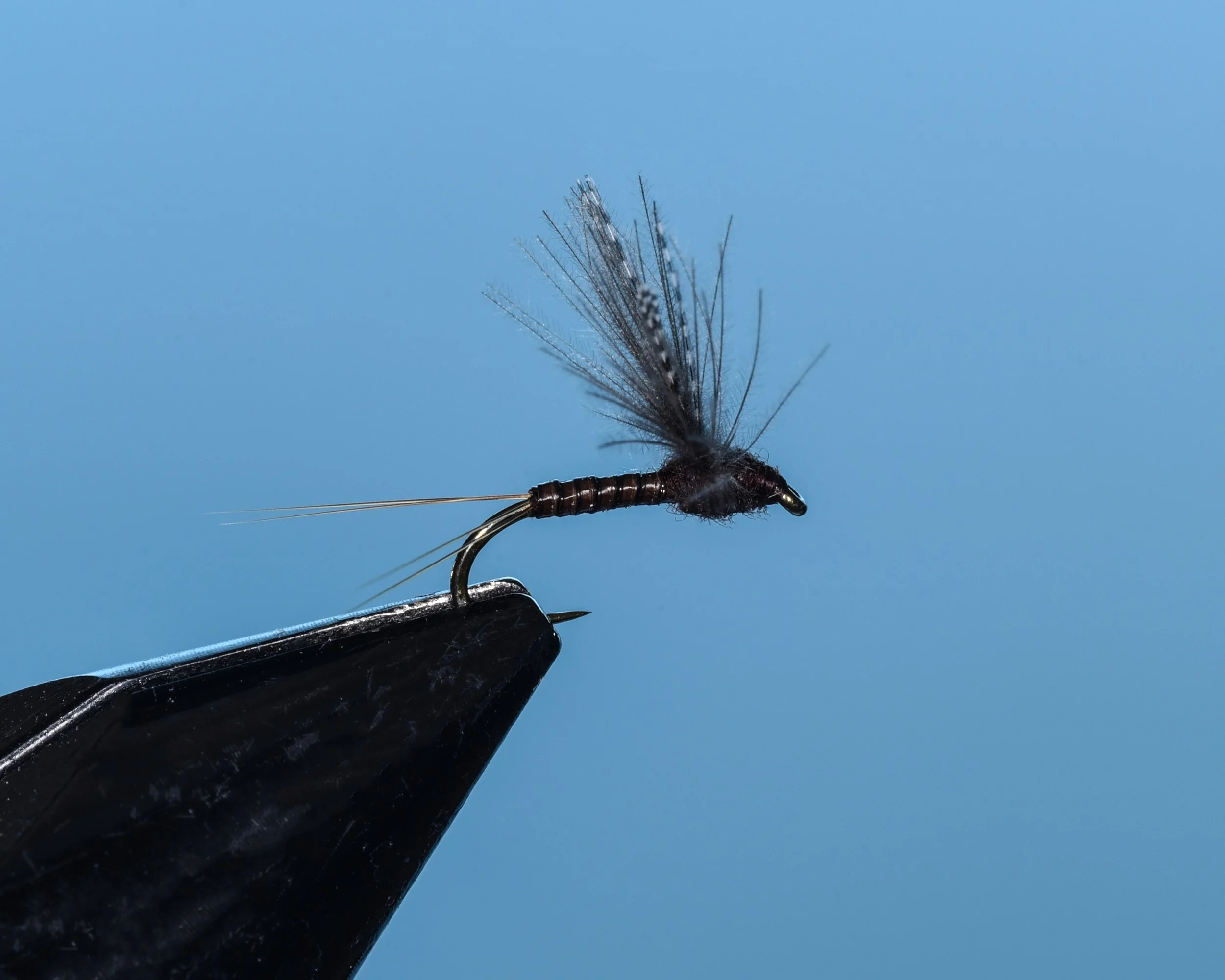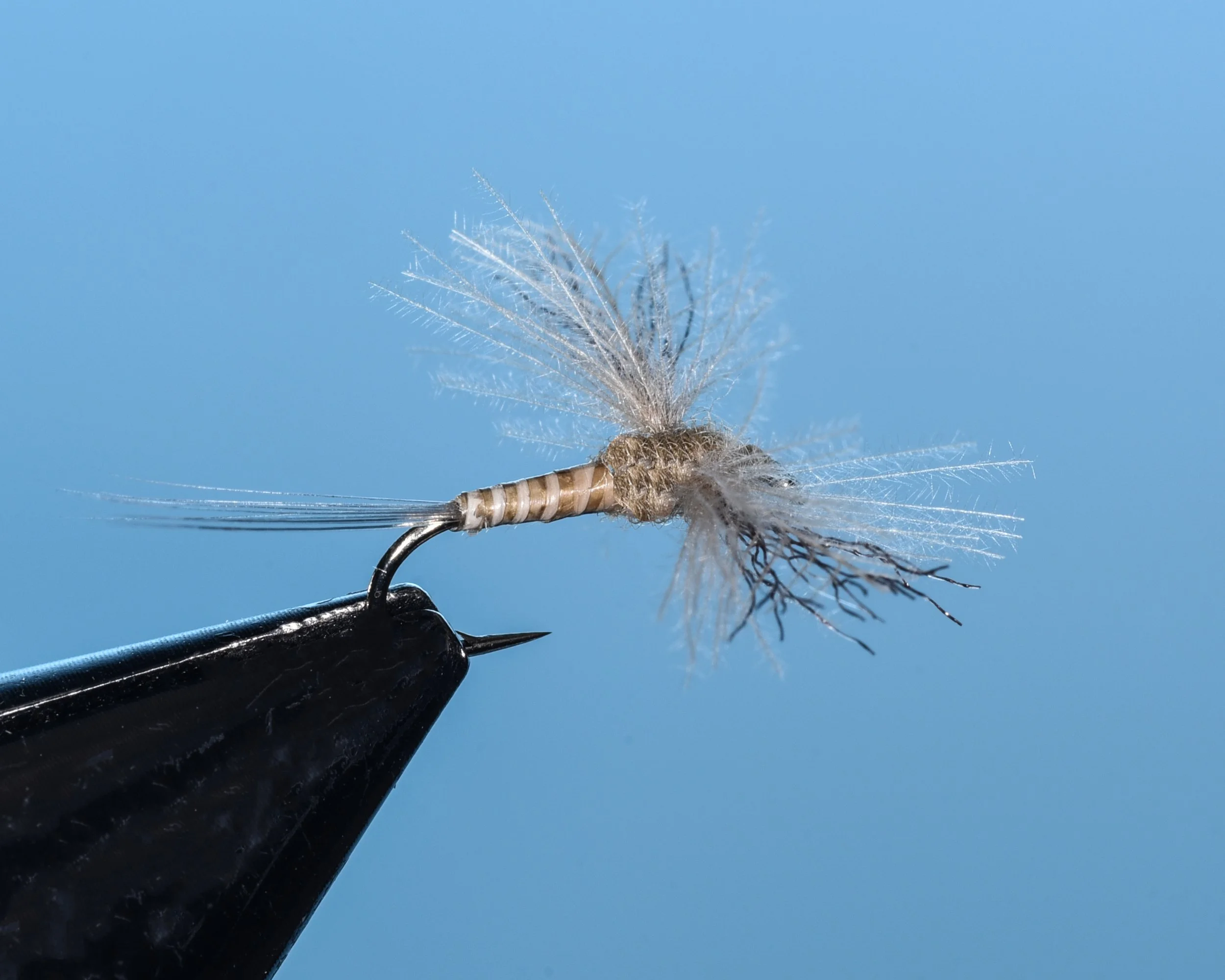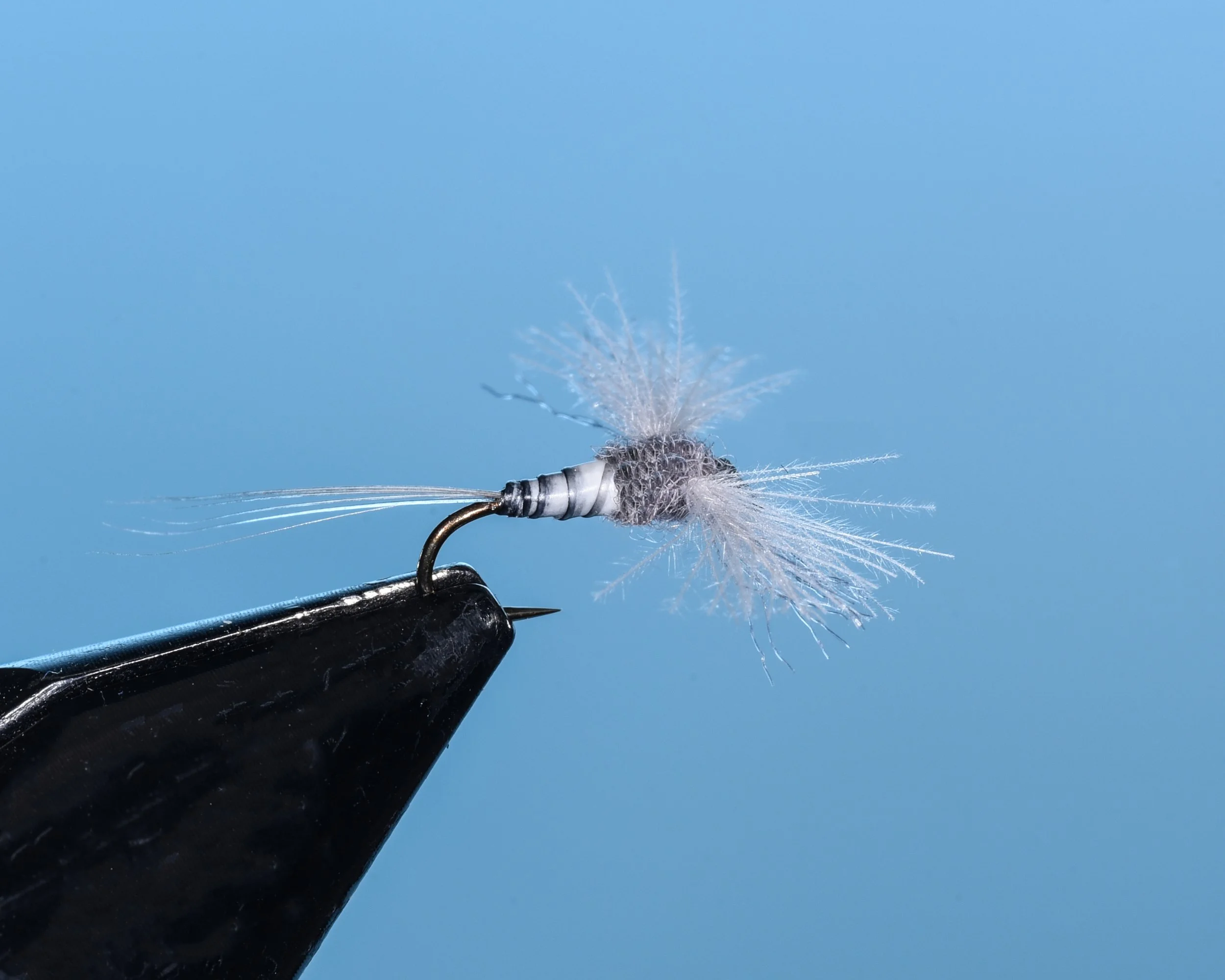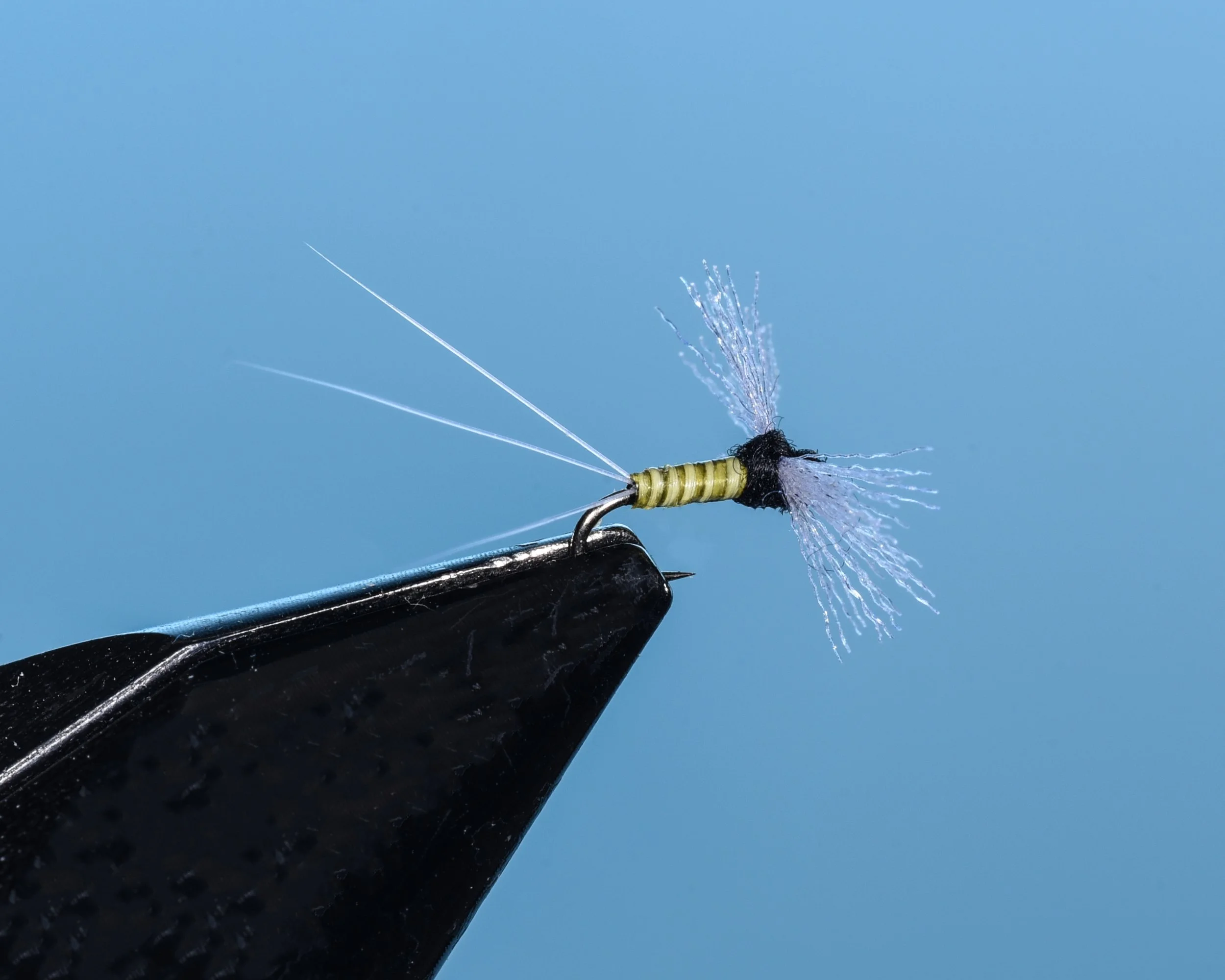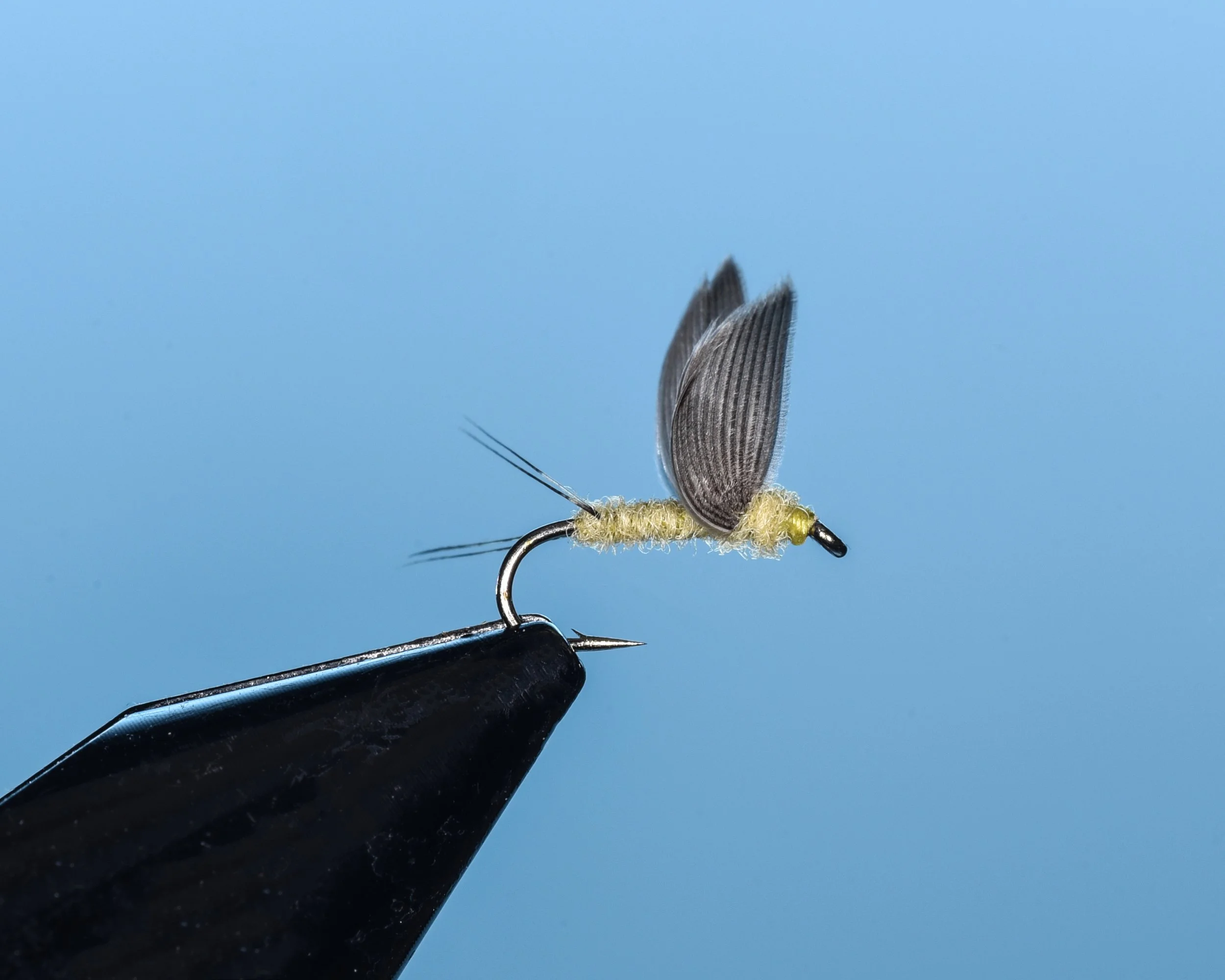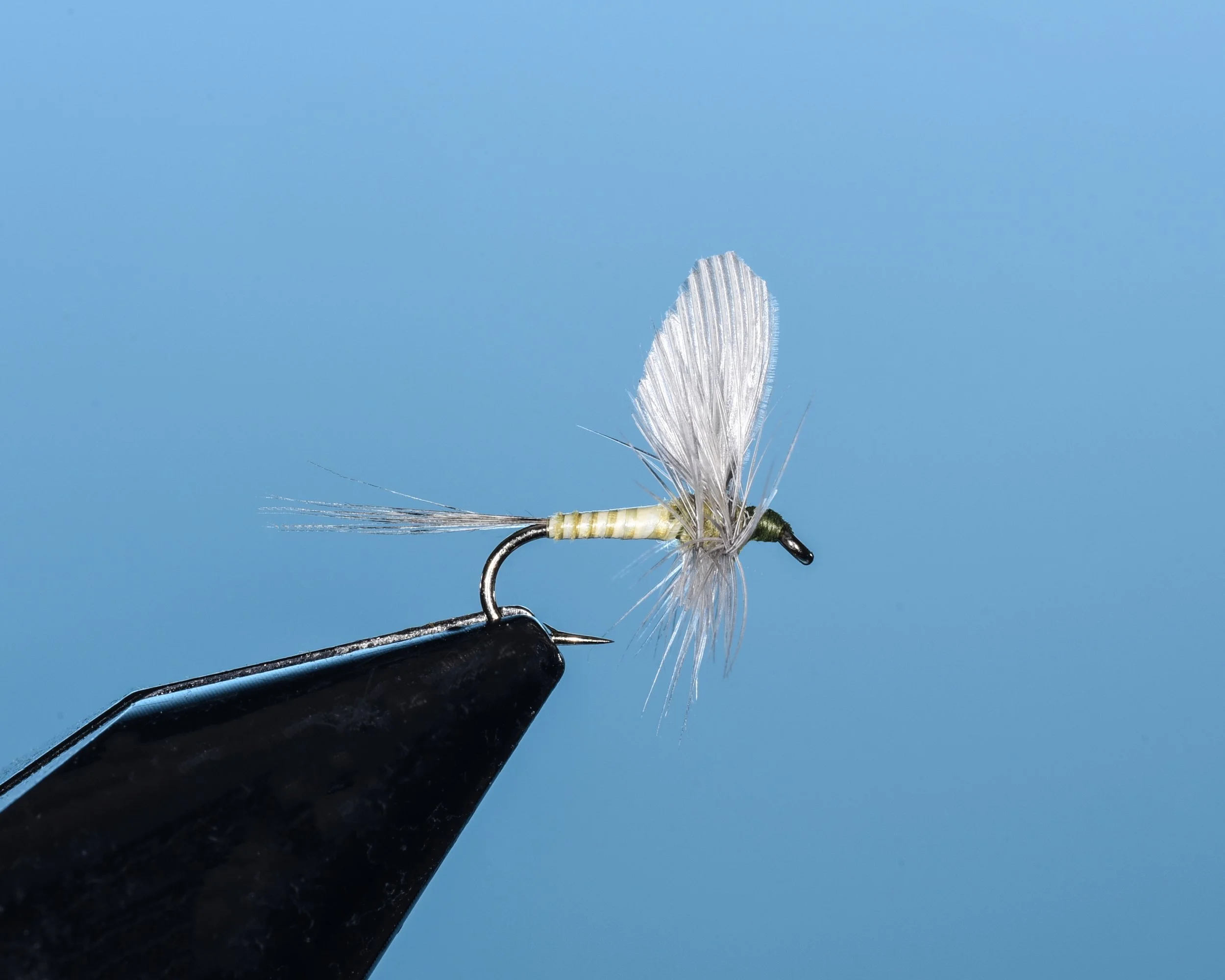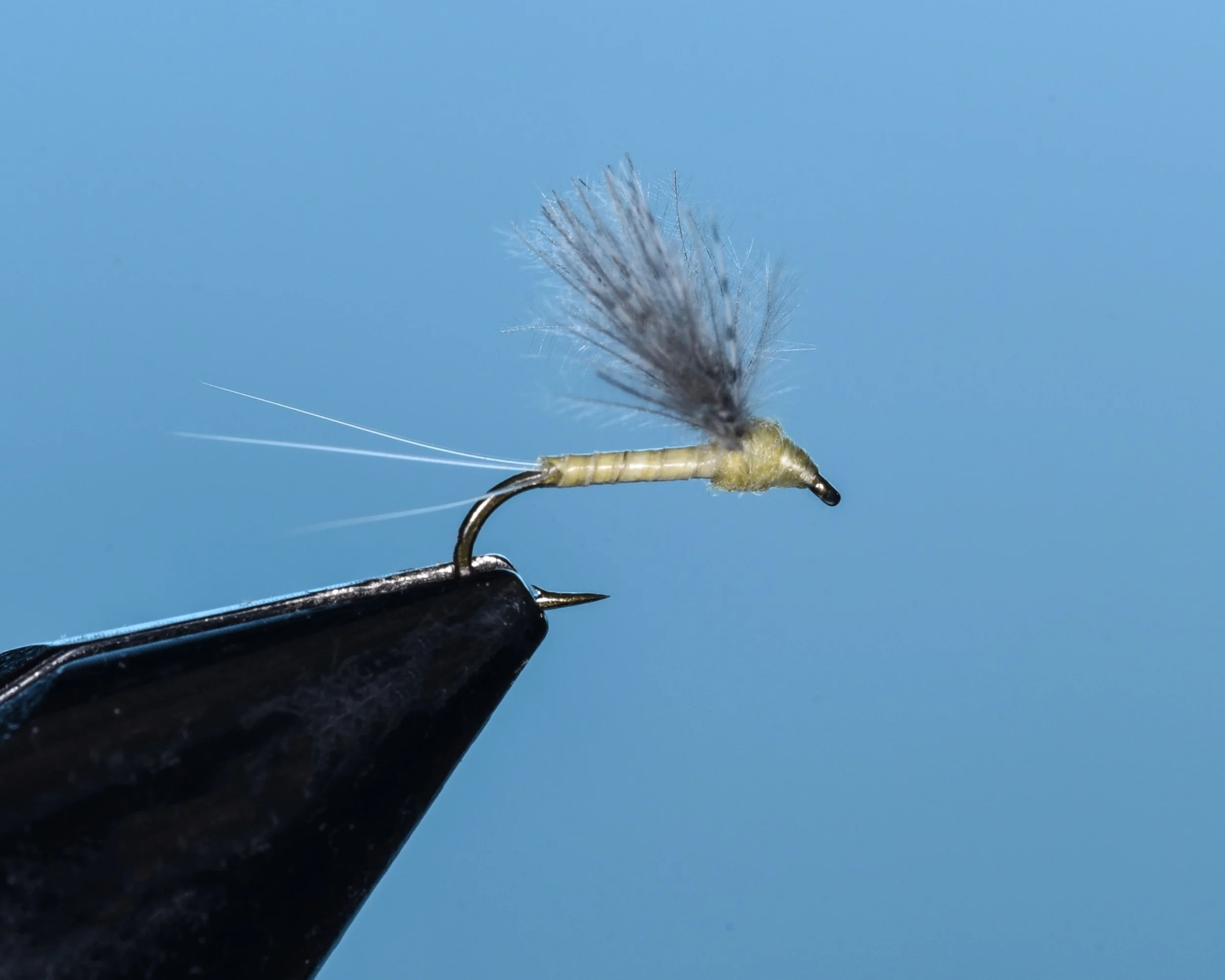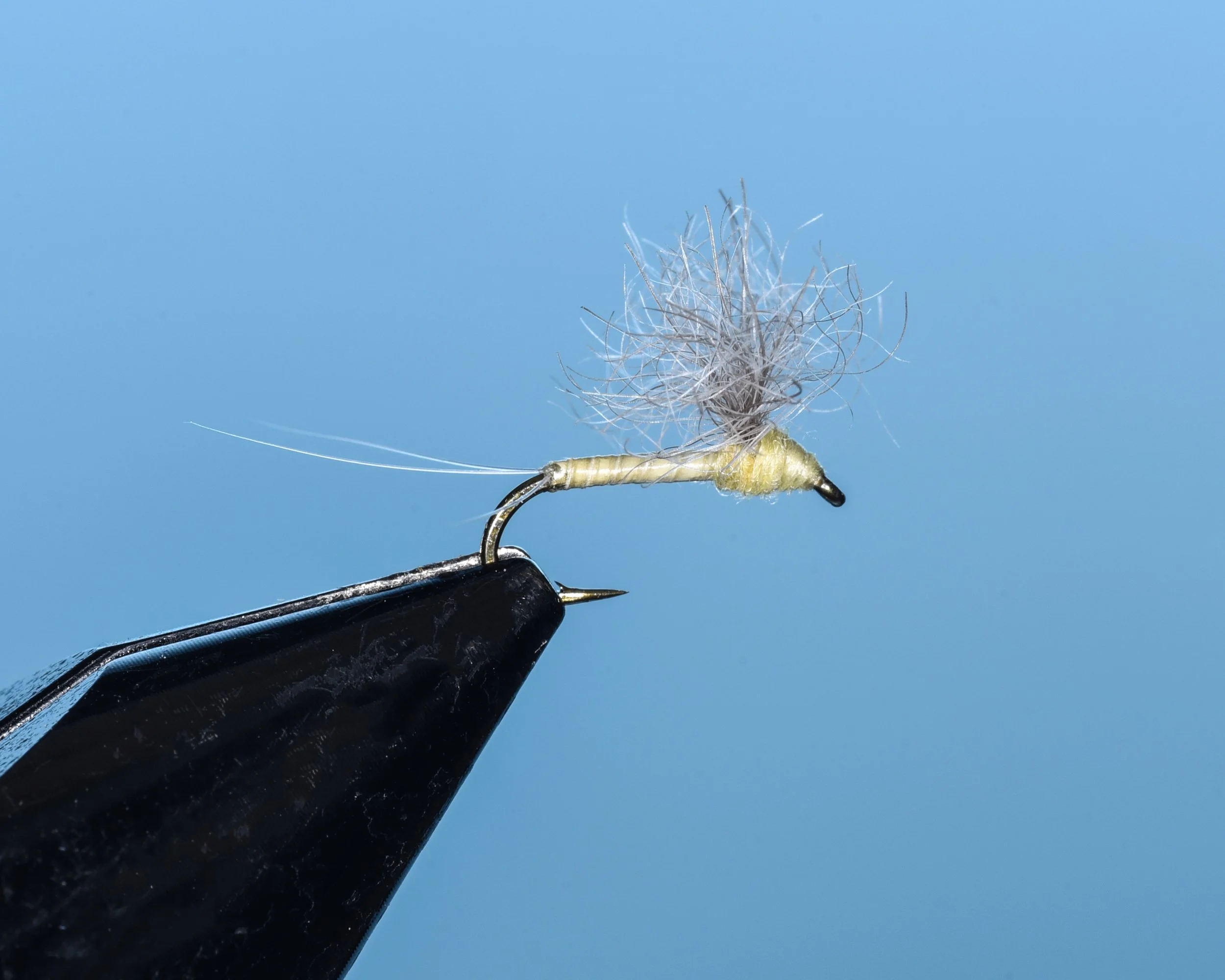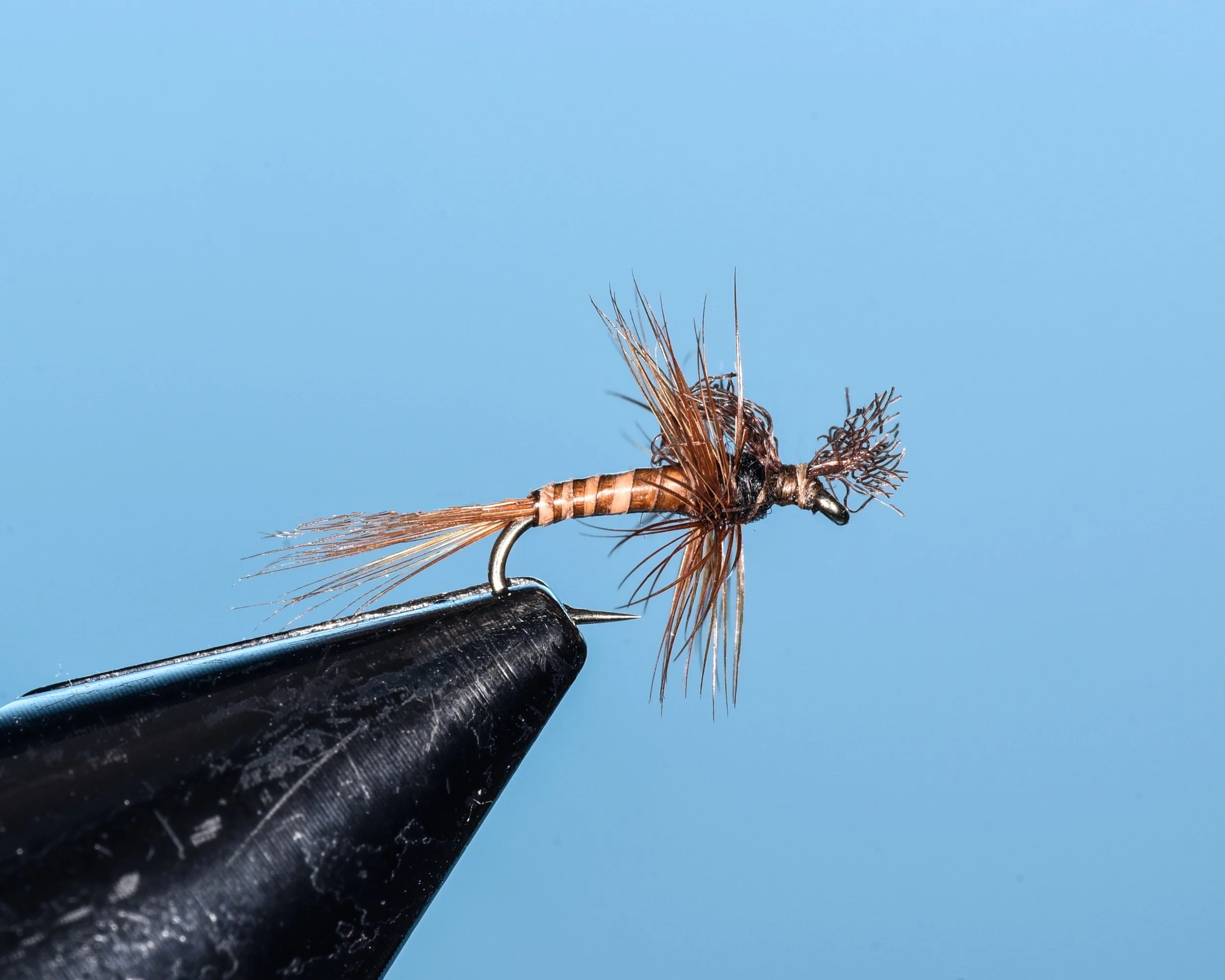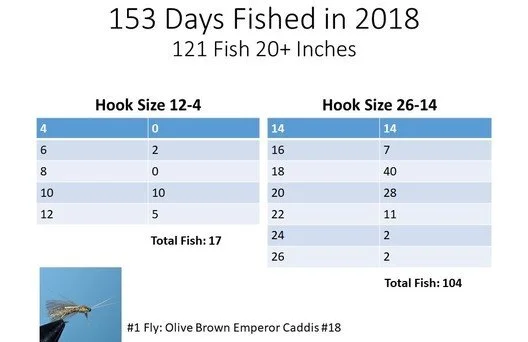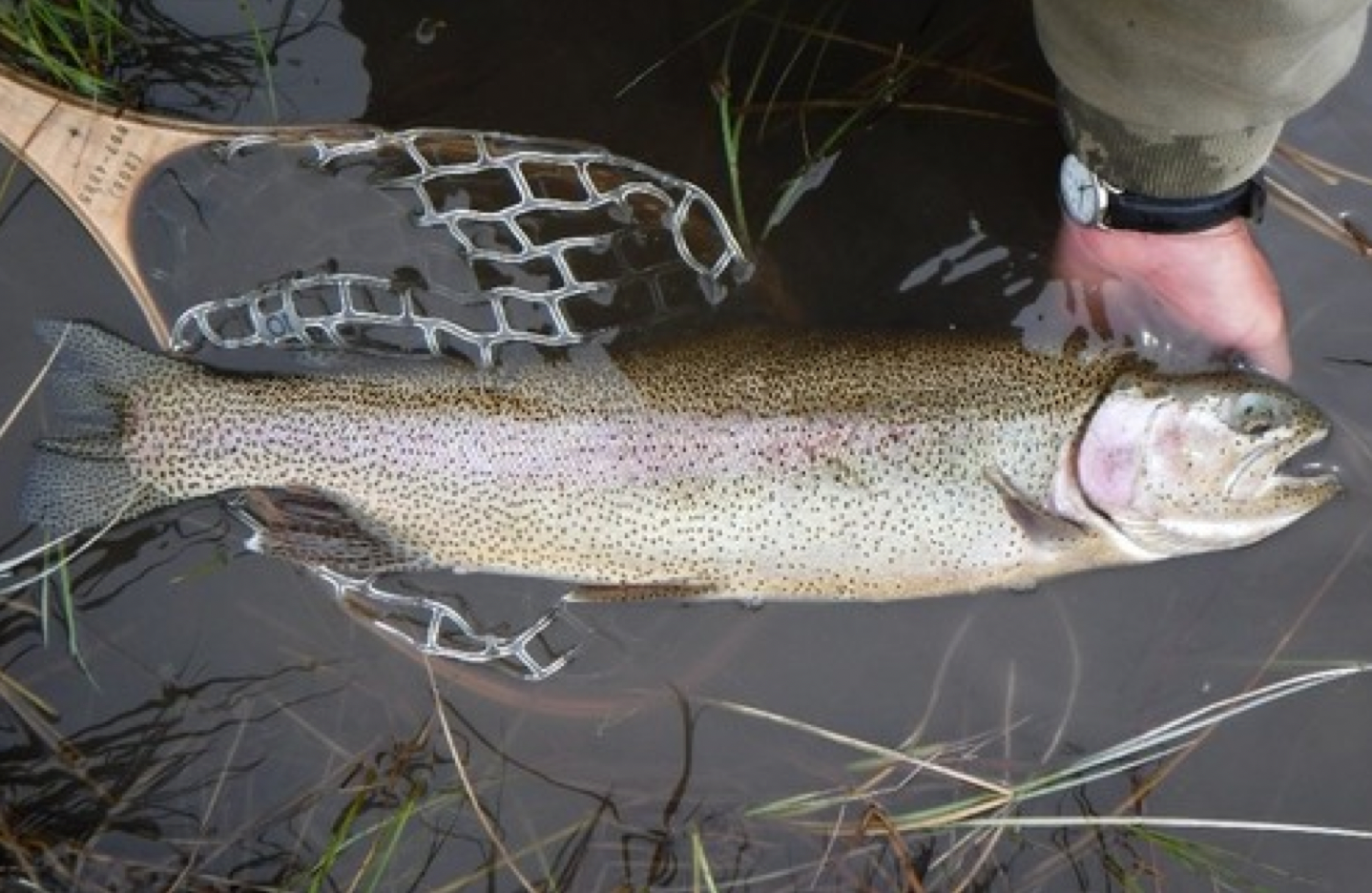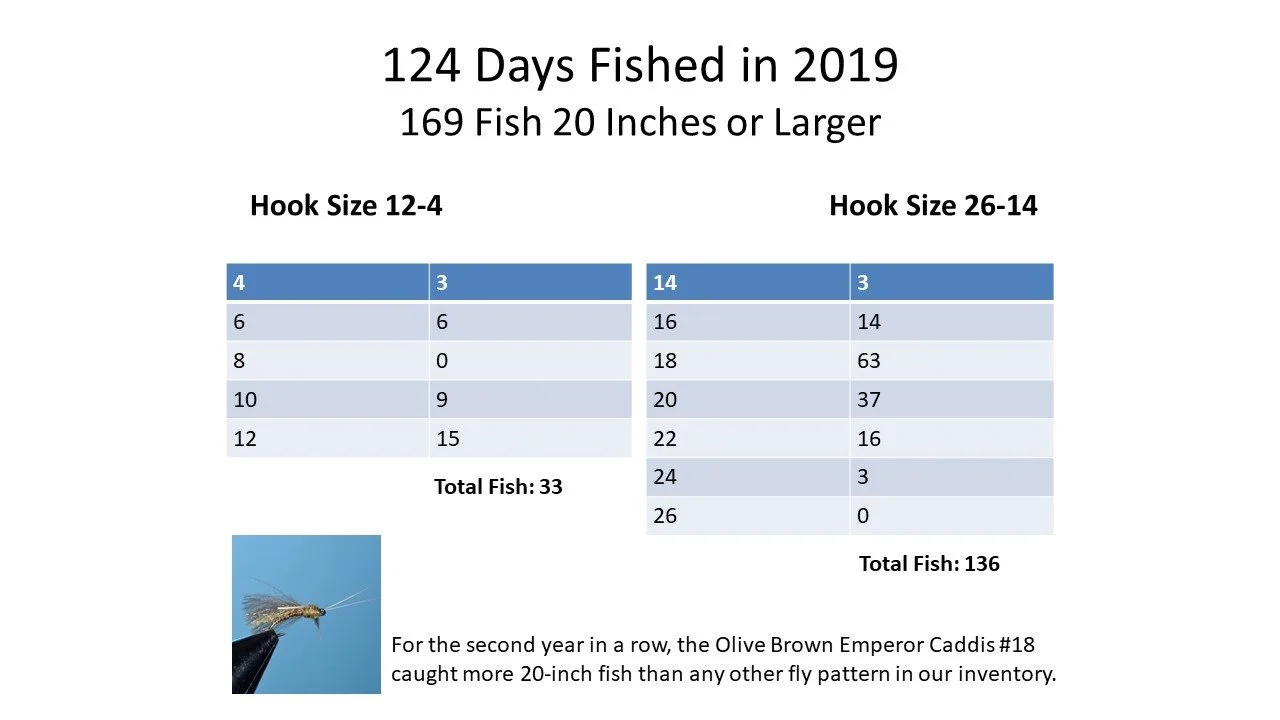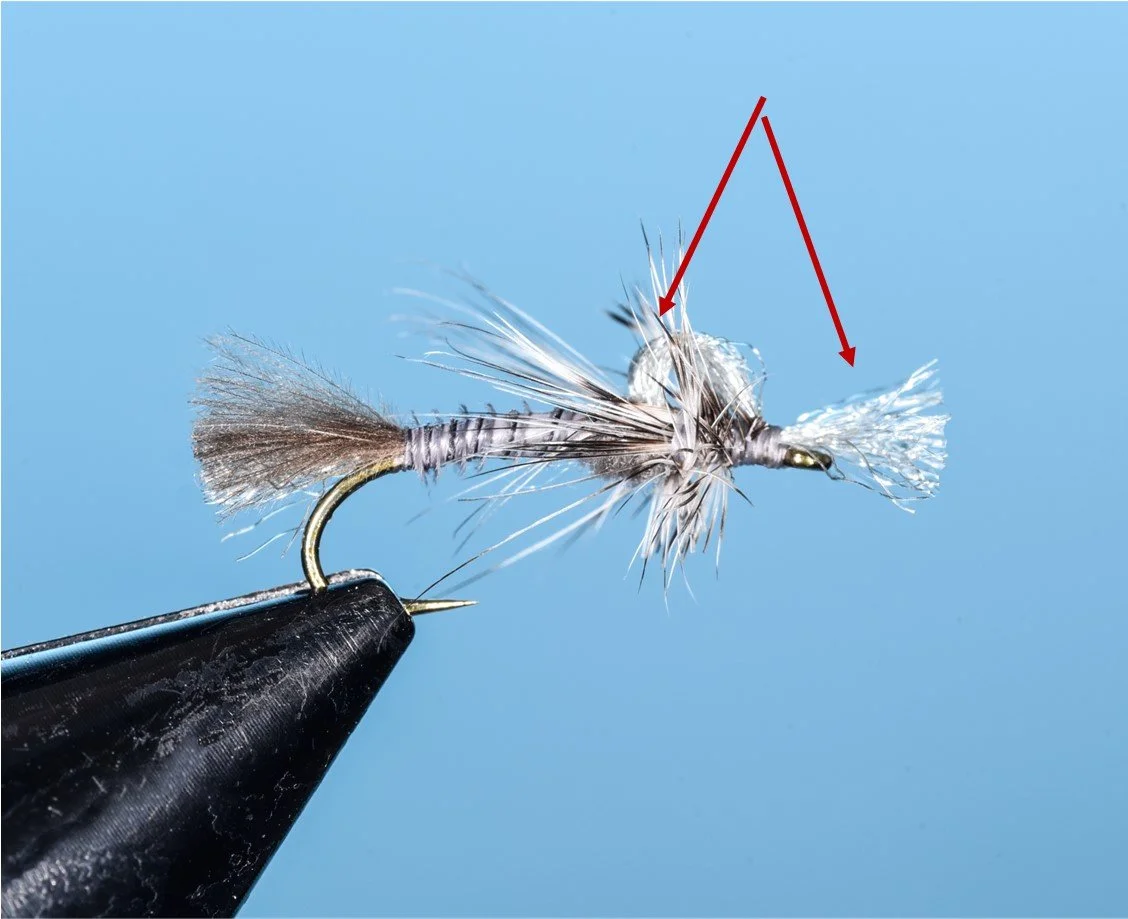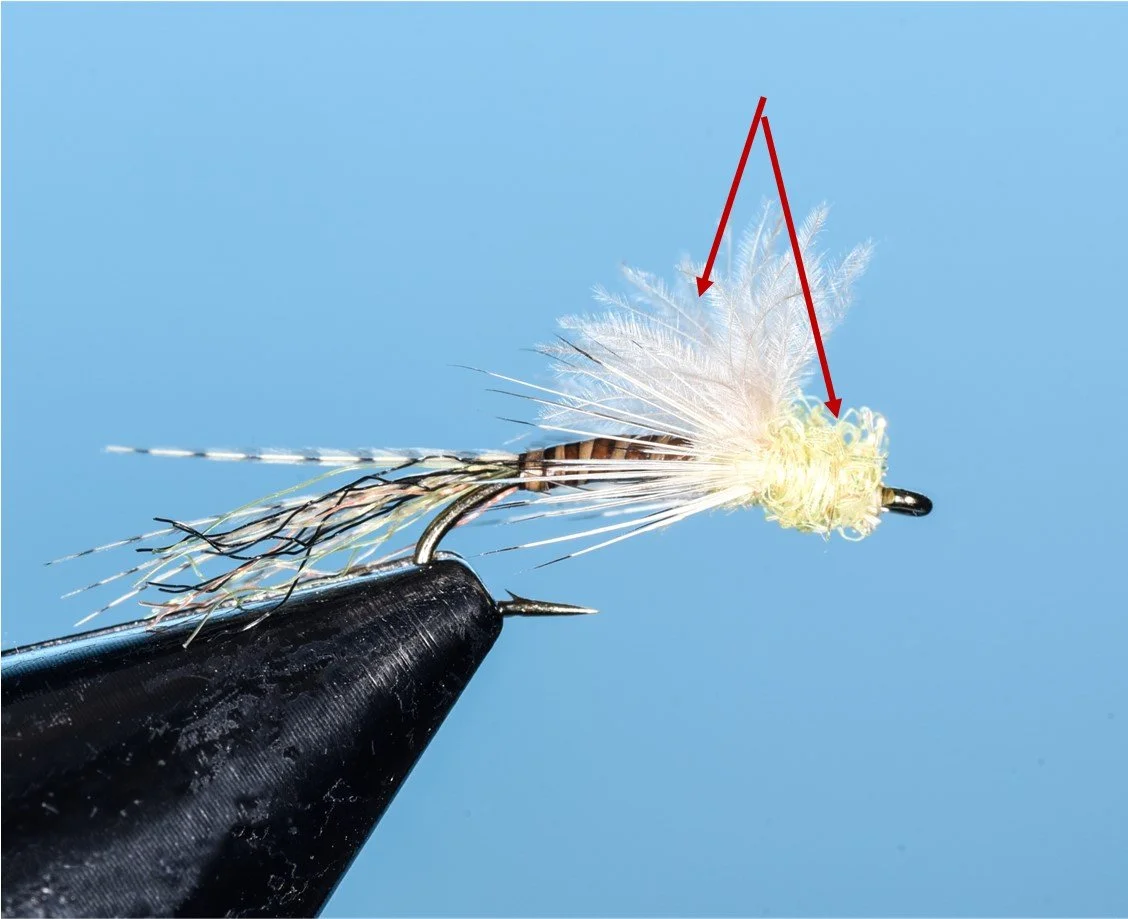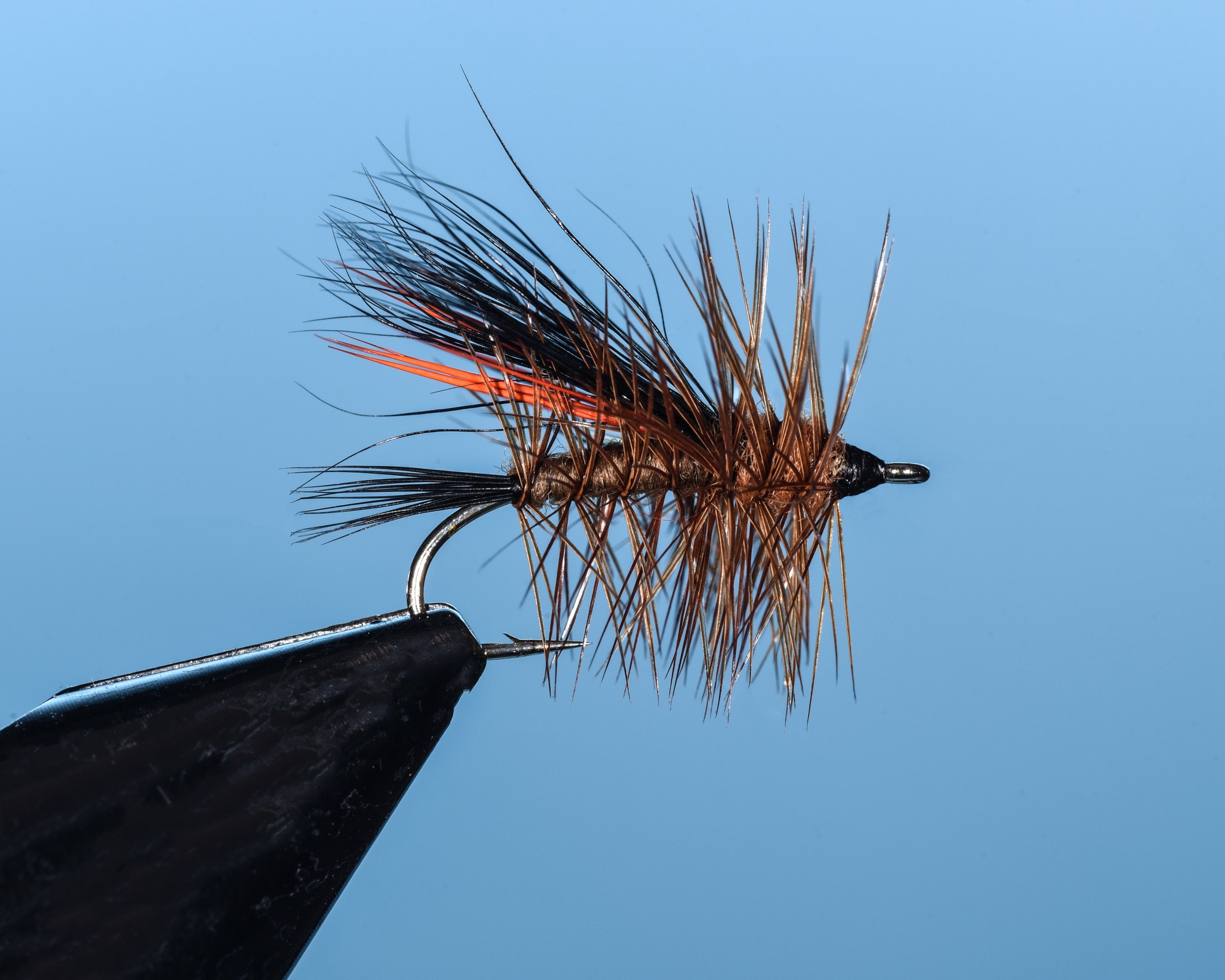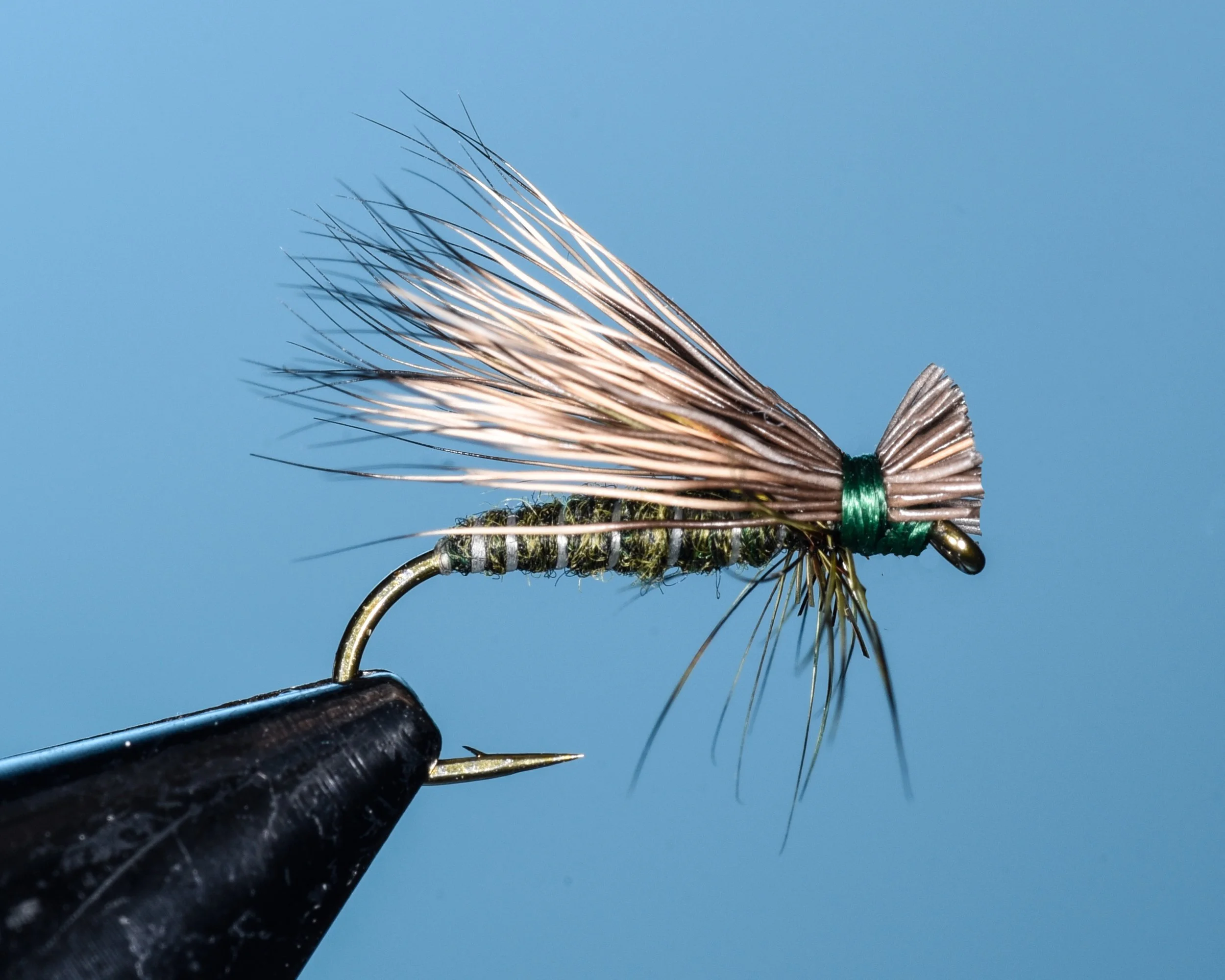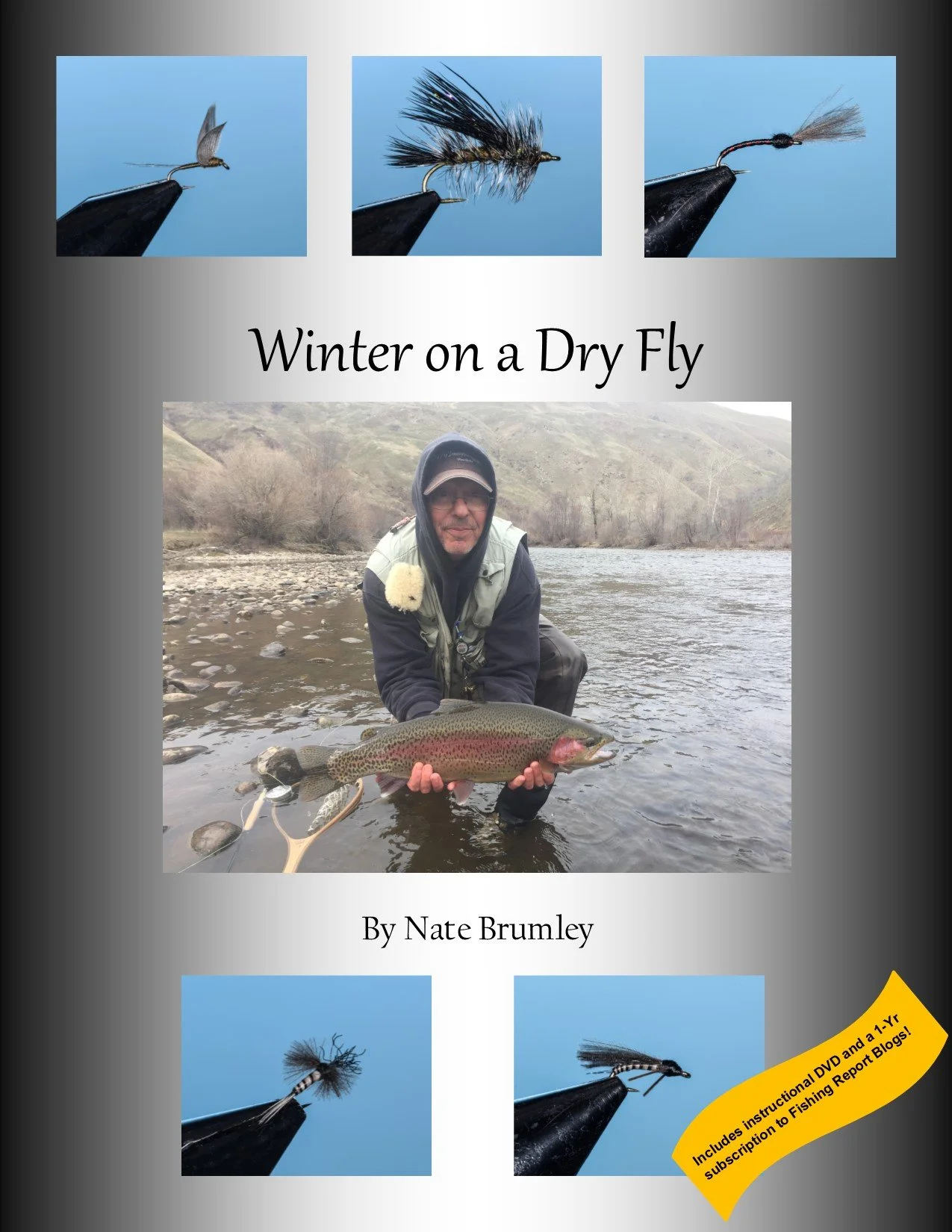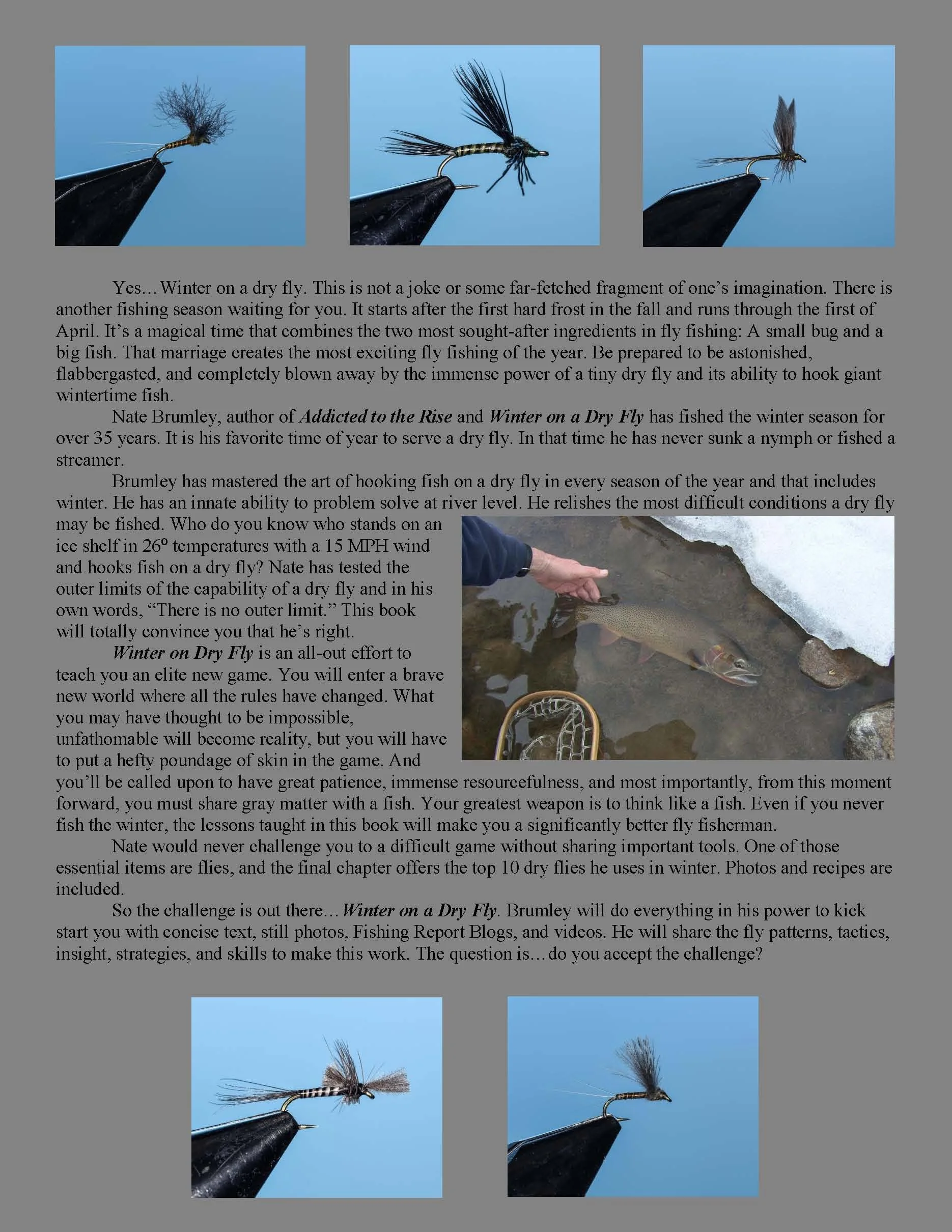
NATE BRUMLEY
The Floating Fly Questions
Here are our abbreviated answers to the 11 questions presented by Chris Rownes. My compliments to Chris on his questions because they go directly to the heart of dry fly. It was obvious that this man has fished a dry fly to be able to pose such questions. Here we go!
1. Choice of equipment: Rods, reels, fly lines, fly floatants, clothes, glasses and other useful items.
Equipment
Rods: Loop 9 ft. Evotech MF in both a 4wt and 5wt. They are a remarkable combination of softness in the cast and backbone in the fight.
Reels: Loop Opti Reels. The Opti Dry Fly model on my 5wt rod and the Opti Creek model on my 4wt.
Fly Line: Cortland Spring Creek. The color of this line is dark green, the perfect stealth color. I would use some of the textured lines from Rio or Scientific Angler, but I refuse to fish bright fluorescent colored dry fly lines. In fact, the manufacturers of dry fly lines should be ashamed to offer bright fluorescents…it’s an insult to a fish’s intelligence.
4. Fly Floatants: Lochsa by Loon Outdoors for all CDC flies and Payette Paste by Loon Outdoors for all hair and hackle.Clothing: I’m not about style when it comes to clothing; instead, it’s all about color and efficiency. Any outer garment that a fish may see is dark olive in color. I wear Simms G4 Pro waders in dark gray. My favorite season to fish a dry fly is winter and I find three garments to be essential:
Merino wool beanie in olive
Merino wool undergarments against your skin. I use Filson products—expensive, but worth it.
Merino wool or bison fingerless gloves
Rain jacket: Simms G4 Pro series
Glasses: Both my clear lens and sunglasses are bifocal with my prescription on top and readers on the bottom. Of course, the sunglasses are polarized.
One other item of equipment that I find absolutely essential is a tool called a “Bugometer.” It measures a live insect into the proper hook size. An article written by our friend and designer, Troy Pearse is linked here: Size Matters. A short explanation and documentation about both the streamside Bugometer and benchside Bugometer can be found here: The Bugometer.
Leader Material: This section is best explained from our book, Addicted to the Rise pages 77-79.
Fine Detail
Successfully fishing a dry fly is never about a “thing.” It is about a bundle of things performed flawlessly every time you enter the water. There is no one detail about dry fly fishing more important than another. And there will never be a silver bullet that will catapult you into dry fly nirvana. In “Fine Details” I will take you to the lowest level of the simplest tasks in dry fly and show you just how enormous that tiny detail can be.
When you grab the rod, don the waders and enter the edge of the river, you have one thought in mind. You are hunting the biggest fish in the system and it is your objective to hook that son of a gun every time you fish. The problem is the biggest fish in the drink has been around the block. He has been hooked before and it is an experience he never wants to repeat. The big fish that live in the streams, rivers and lakes across the world have attained a higher level of awareness. They are the first to read your wade wake, the first to disqualify your fly as fake, and they are the last to succumb to your imitations. That fish got big because he learned how to avoid you.
In order to compete with this group of fish, you must activate the tiny details of dry fly. When David felled Goliath, he did it with a tiny stone. There are tiny stones in dry fly that can be large weapons against big smart fish. So let’s take a look at dry fly fishing in detail.
Tapered Leaders and Tippet
Oftentimes we don’t think much about tapered leaders and tippets. It is just a chunk of leader that attaches to a fly. Most anglers loop them together with dry fly line, tie on a fly, and forget about them. I look at leaders as one of the most important tools in the dry fly arsenal. I use leaders to present a fly perfectly. I want leaders to create stealth in my delivery, maintain large invisible zones around my fly, and float a bug exactly like a natural insect. There is a lot to know about leaders. When you utilize them for full effect, they assist you in hooking many big fish.
Stretch Line
Tapered leaders come in a coil and tippets are wrapped on a spool. They have circular memory when they are unfurled. Memory must be completely removed from leaders before you make the first cast of the day. The first thing one must do upon arriving at the river is rig the rod, place the fly in the keeper, and stretch the leaders. Nylon leaders need 20 minutes stretch time to remove all memory. During stretch time you can go about putting on waders, boots, and organizing the rest of the gear. By the time you are ready to fish, the tapered leader and tippet will be well stretched, straight, and ready to deliver.
When stretching leaders DO NOT bring the leader under the reel and then attach it to an eye on the rod. Where the leader goes around the reel, it creates two kinks in the tapered leader or tippet. When the fly is released from the eye, you no longer have a long, straight leader. Hook the fly in the keeper to transport the rod to the next fishing hole.
Tippet Formula
All the dry flies we sell in Sizes 24 through 4 can be fished on three tippet sizes: 4X, 5X, and 6X. I never use anything smaller than 6X and rarely anything larger than 4X. Many times we think 7X or 8X tippet is a necessity to fool big fish on spring creeks or in critical slow-moving water. I use 6X in those situations because I want the extra strength to fight fish and keep them out of the moss beds. Tippet size doesn’t put fish down, bad deliveries put fish down. Remember the rules of delivery. All perfect deliveries present the fly to a fish before he recognizes the attachments behind it. If the only thing a fish sees first is your bug, the size of the tippet becomes much less offensive to a fish. Here is a chart that will help you match size of tippet with the proper size of fly.
Tippet Size
Hook Size
6X
#26 - #20
5X
#18 - #12
4X
#10 - #4
The world of dry fly revolves around small bugs—Size 20 through Size 14. The tippet size that will fish the greatest number of bugs is 5X. Own more 5X than any other size in both tapered leaders and tippet.
Invisible Zones
The next extremely important function of leaders is the ability to fish dry flies invisibly. When I wade fish, I use 7½-foot tapered leaders exclusively. These leaders have a short taper of heavy course line at the top of the taper. When a splice of 6 to 7 feet of tippet is added to the 7½-foot tapered leader, you then have 10 to 12 feet of fine leader following your fly. That establishes zones of invisibility because all that fine line around the fly is very difficult for a trout to see.
I use a lot of leader between my dry fly line and the fly, somewhere in the range of 13 to 15 feet. You may think that amount of leader would be difficult to cast but remember there is three feet of heavy taper at the top of the 7½-foot tapered leader. That is enough stiff line to drive 10 to 12 feet of fine line and your fly in a straight line. Start using more fine leader. Big fish are much more likely to eat your bug when there is no heavy line close to the hook.
Stealth
Another function that I demand of all tapered leaders and tippet is an element of stealth in my delivery. A cast should always be quiet going out, but you want the retrieval of line to be equally as quiet. By quiet I mean no wakes or V-rings coming off the dry fly line and leaders when pulling the line back.
Dry fly line and tapered leaders both have loops that can be connected for fast changes. Many anglers change tapered leaders in this manner. It is convenient but you have just destroyed that quiet retrieval. When the loop knots come together, there is a heavy, bulky knot. Every time you retrieve line, a large “V” forms right at that knot. You are now creating a commotion at the surface that a trout can both see and feel. Loop-to-loop is costing you big fish and it will stay that way until rigged differently. Here is a rig that will keep you quiet.
Start at the end of the dry fly line by clipping off the loop. Don’t feel bad about it either because that loop is scaring fish.
Unfurl a 7½-foot tapered leader and cut the loop off it also.
Connect the 7½-foot tapered leader to the dry fly line with a 6-turn nail knot. Don’t add any more turns than six because that will bulk the knot.
At the end of the tapered leader slice on a matching or one size smaller piece of tippet. That splice knot should be a 3-turn surgeon’s knot. I would use about 6 feet of tippet. If you struggle to cast this much tippet, shorten it to start. As you control your casts better, begin lengthening the tippet. You want as much fine line as possible.
Now tie the fly to the end of the tippet with a 6-turn improved fisherman’s knot. Moisten the knot with saliva then pull the knot tight. *Extremely Important!* If you cinch the knot and a kink in the tippet forms just above the hook eye, you have tied a cockeyed knot. A cockeyed knot will not float a bug properly. ALL tippet must run straight into the eye of the hook. If there is a kink, retie the fisherman’s knot. I don’t use fluorocarbon leaders because they sink and create memory at the knot.
You can fish the tapered leader attached to the dry fly line for several fishing trips but eventually it will need to be changed. Clip the tapered leader about 20 inches below the nail knot. You have now created a “butt piece” which is connected to the next tapered leader. Use a 2-turn surgeon’s knot to make this splice.
By rigging in this manner, there are strong, tiny, indiscreet knots that hold long leaders together. The knots are quiet and create very little commotion at the surface. When stealth, invisibility, and presentation are all tied into your tapered leaders and tippets, you will hook more big fish.
The final function of tapered leader and tippet is VERSATILITY. You create this using two rods. When I trout bum, I have two rods rigged at all times. My 4wt would always be rigged for a small fly; my 5wt is rigged for a large one. With two rods, I don’t have to change out tippet to adjust hook sizes. I simply change rods. In summer I will normally rig the 4wt with 5X tapered leader and the 5wt with 4X. The 4wt has great versatility because I can fish a Size 18 PMD on a 5X tippet. At daylight in a Size 22 trico hatch, a slice of 6X tippet to my 5X tapered keeps me right on fishing a smaller bug. I don’t generally change much on the 5wt rod with 4X tapered, but if the hatch demands it and the 4wt is in the car, I can then splice 5X tippet below the 4X tapered and fish a small bug. By making minor adjustments, I can fish every size bug I own on two rods rigged in this manner.
Recently in winter, I have changed the gearing of leaders to best fit the personality of a wintertime fish. I now construct leaders that are much longer, but still based off a 7½ foot 4X tapered leader. I then splice a short piece (2½ to 3 feet) of 5X to the 4X tapered leader with a 3-turn Surgeon’s Knot. Then I attach 6-7 feet of 6X tippet to the 5X tippet. That creates a total leader of somewhere in the neighborhood of 18 feet, which is perfect for the water clarity and spookiness of a wintertime fish. Add to that, I always fish with the wind which will carry 18 feet of leader plus the fly exactly to target.
Approach and Stealth: Approaches and stealth are the highest priority skill in dry fly fishing PERIOD. It’s the first chapter in Addicted to the Rise and it’s the Prerequisite in Winter on a Dry Fly, pages 7-9 and Addicted to the Rise, pages 6-7. Here’s the introduction to Chapter 1 in Addicted to the Rise.
Approaches
You can be the greatest fly caster on earth, own the finest dry flies known to man, and read holding water like a book. You can wield the finest, most expensive fly rods, hang all the cutting-edge fly gadgets off your vest, but if you don’t understand approaches, you’ll only fish to a small population of big fish for the rest of your life. The average fly fisher puts down and scares away significantly more fish than they hook. The problem is the fish won’t send you an email that reads like this: “You bull rushed my home like a moose; you waded in too fast; you slapped the water with your fly line; and you created wake like an ocean wave.” The fish won’t share with you your mistakes so your approach never changes and you continue to put fish down before you ever have a chance to catch them. There is a golden rule in dry fly that goes like this: If a fish sees or feels your presence before you deliver your fly, you lose. That fish will never entertain your bug because alerted fish hunt cover and protection, not your fly. Approaches is the single most important skill to dry fly fishing PERIOD.
So what is an approach? An approach is a conscious, premeditated plan of action that puts you in casting range of a fish before it recognizes that you are there. You are always in charge and in total control of your approach. You have only one chance to get it right in each new set up. A blundered approach can sour a whole run of great fishing water leaving you scratching your head and asking, “Where’s all the big fish?”
Approaches are intricate and they demand a specific thought process before each new execution. Many times an approach is formulated around a group of feeding fish. That makes a stalk much easier because you see the target and can formulate an assault exactly to a location. Other times you must plan an approach to holding water where no fish are rising and the process then gets a little squirrely. In this case, you must read the entire length of a run of water, designate the zones of water that you know holds fish, and then plan your approach based on productive holding water.
There are many things that can alter your approach such as wind, water depth, and topography of a river canyon. Even a tree canopy extending over water will affect your tactic. A specific rising fish will always dictate a managed approach. In “Approaches” I will share insight on positioning to best utilize the runs of water you fish. We will also explore modifying methods when Mother Nature throws you a curveball.
In the world of approaches there are cardinal sins that a fish will NEVER forgive. We underestimate or simply don’t understand what offends a fish and that is a recipe for perpetual failure. To keep you in the “Fish Love” zone, I will propose an extensive list of things you can NEVER do.
There is a principle in dry fly fishing that says, “You should always approach to a fish’s weakness.” It is a great principle, but if you didn’t understand what a fish’s strengths are, you would never be able to exploit its weaknesses. All knowledge of approaches starts at fish level and I would even dare to say you must think a little like a fish.
Fish have two great abilities to detect your presence: They see you and they feel you. You must fully respect these two skills that fish possess. Every pure approach should calculate how to minimize these sensory organs of a fish.
Now, here are some ironclad rules that will help you with a stealthier approach.
Prerequisite
In my previous book, Addicted to the Rise, there is an entire chapter dedicated to Approaches. It is a thorough study of the awesome capabilities of a fish to both see and feel. In an effort to not be redundant, I won’t repeat the details. But if you intend to fish the winter, that information is not only essential, it is required. I would be doing you a complete disservice without highlighting some of the important concepts in that chapter.
The approach on a winter fish must be cunning, stealthy, and premeditated. A river’s flow will always be at its lowest and water clarity at its highest in winter. That means a fish can detect your presence much easier. “HE SEES YOU!” “HE FEELS YOU!” Any fish that recognizes you will not eat your fly. Spooked fish seek shelter and protection in the deeper water of the run you are addressing. There are some iron-clad rules of engagement in winter that must not be broken:
Two positions on a river where fish will always see you.
If you are fishing downriver, it places you in front of the fish exactly in his viewing area. You are much easier to see in a downstream approach.
The second location that is probably the most offensive to a trout is being above him. His upward cone-shaped vision makes it super easy to see you on any elevated position in front of his head. We often make the mistake of parking on a road right above a run of water we intend to fish. Then, we go out to the edge of the bank in full view of the fish and study the run from above. In our mind we’re thinking, “I’m 60 feet up the bank from the river and a fish is certainly not going to see me at that distance.” WRONG! Every big fish in the run of water below you will immediately see you and they are alerted to your presence. Your chance of hooking one of those large fish has just been severely diminished. I have been on steep banks 100 feet above feeding fish and put them down because they saw me.
Establish safe distances between you and a feeding fish.
If you are upriver of a fish in riffle water, cast to the fish at a distance no less than 25 feet.
If you are upriver of a fish on a slick surface, deliver your fly at a distance no less than 35 feet.
If you are fishing upriver to a feeding fish, make your cast at a distance no less than 20 feet.
Any riffled surface will diminish a fish’s ability to see you. Any slick surface will expand a fish’s ability to see you at greater distances.
Fishing spring creek conditions generally entails slow-moving slick surfaces with crystal-clear water. All distances to the target may need to be expanded. I have seen times that if you were above a pod of feeding fish in these conditions, your approach would have to end before you reached casting range. In this case you long cast then feeder the fly the rest of the distance to the fish.
Don’t enter the river from high to low above a line of water you anticipate to fish.
If you must go down a steep bank, always be in the cover of brush, trees, or rock structures.
If you expose any part of your body or the fish sees any movement through the brush, the big fish will identify you and be reluctant to even consider your fly.
Rules for wading.
If you don’t have to wade to get in position to deliver a fly, just don’t do it.
If you must wade, move cautiously and create as little wake as possible. Remember, it’s the wake that a fish will detect.
When wading, penetrate the water with your toe rather than the broad flat surface of your foot. This creates less wake.
If possible, land your feet on sandy or soft bottom rather than rocks. If two rocks click together, you have created a sound wave that travels well underwater. The fish will then detect your location.
Slow down—the one biggest problem in dry fly is we have a tendency to fish too fast which creates greater turmoil at the surface of the water and in turn, alerts many more fish to your presence.
Fish alone. You can travel to the river with all the fishing buddies you want, but when you reach the destination, break up and each person enters a separate run alone. A single person fishing at a slow pace creates enough water commotion, so don’t multiply that by adding more people in the same lie.
Never…
Cast your shadow across water you intend to fish.
Slap the water with your fly or your floating line.
Rip line off the water to recast because that generates both sound and wave vibrations that fish will detect. Instead roll cast your pick up for a quiet exit. Then continue the execution of your next delivery.
Put dry fly line over the top of a feeding fish.
Use fluorescent-colored line. The next time you purchase dry fly line, choose an olive-colored line as the first requirement.
Walk the well-trodden fisherman’s trail. Most trails are cut on the banks of the river in full view of the fish that live there. Create your own trail completely out of sight.
Review this Prerequisite often and obey the rules because all the information within Winter on a Dry Fly is useless unless you apply these approach techniques.
FISH SLOW,
HAVE GREAT PATIENCE, AND
BE TOTALLY INVISIBLE TO A FISH!!!
Reading Holding Water: Reading holding water is really about understanding where fish live. That knowledge can direct a smart dry fly to those zones of water. This segment can be best understood through Chapter 4 of Addicted to the Rise, Pages 59-61.
Where Fish Live
If you could walk to a riverbank on any river and know precisely where fish lived, how many more fish would you catch in your lifetime? How awesome would it be to drive along an unfamiliar river, yet know exactly which run of water stands the best chance for production? You’d then skip dead zones and focus on water that holds the greatest population of fish. Rivers may have different names but holding water within them rarely changes; that knowledge can be applied anywhere on earth.
Of course, there are always exceptions to the rules in dry fly. If you fish a spring creek with crystal-clear, slow-moving, slick-surface water, the rules then change. There is no distinctive structure that can be detected and the whole river system is one big, flat surface. But even on spring creeks there are specific zones that hold more fish.
We are going to take you inside all fishable water and dissect critical locations that house fish. (In the book, we use video segments to show you these locations, but that is too cumbersome for this manuscript.)
Boulders and rip-rap edges describe zones of water laced with rock structure. The banks of the river will have both small and large boulders and they extend out into the river. Many large rocks are underwater while others may protrude through the surface. There is literally a field of boulders randomly spread throughout the run.
This run of water may hold the greatest population of fish compared to any other section of the river. The rock structure creates a unique environment for a trout because it is rich in resting areas protected from current. There are also multiple currents diverted in and around the boulders that perpetually deliver food to a fish. Boulders also provide resting areas for a myriad of insects that eventually end up at the surface of the water and are eaten by a fish.
When a large boulder exists in moving current, there are predictable areas where fish will live. You will almost always find a large fish holding in front of the boulder in an area we refer to as the “push.” One would calculate that a fish living in stiff current in front of a boulder would have to work hard to stay there. But, as the main current slams into the front of a boulder it rebounds upstream, creating the push. A fish settles in the push almost effortlessly with a field of moving water carrying food to him.
When the current moves around a large boulder, fish will hold in the soft water behind it. As the two currents that come around the boulder move downward, they flow back together. Where they meet is an area called the “tongue.” A large fish will live there as well.
A blue line is a unique area in a riffle where the faster center current meets a soft edge of nearly currentless water. That transition line will always hold the greatest number of fish in a riffle. The “money zone” where fish will hold will be two to four feet wide and it will run the full distance of the blue line. The blue line is also referred to as a “seam.”
Do not finish fishing a riffle until you have reached the very top. Big fish are greedy and here they get the first choice of food entering the run. You will hook a lot of big fish at the very top of the riffle.
Foam lines are not truly defined as holding water but they tend to draw fish. Foam lines can be found in numerous zones of water and fish use them as food gatherers. Tiny bug wings and legs get tangled in the foam and begin to accumulate in long food lines. When fish are in a feeding mode, one of the first places that they will visit is foam lines. Ride your fly on the edges of foam lines and you will have a lot of trout visitors.
Fast water is created when rivers have a lot of fall or they drop in elevation quickly. There is very little holding water for fish to live in the main current except for locations behind large structures like boulders. Fish will then move to soft edges right on the transition line between fast and slower water. I am reminded of the Madison River as the definition of fast water because it is known as the “100-Mile Riffle.” There are still many large fish that live in the Madison River because they hold behind boulders and live on the transition lines described here.
Inner chutes are where a portion of the current is split off and redirected toward the bank. Invariably a fish or several fish will call that location home.
Frog water is any currentless water that sets off the main channel. Most of the time fish don’t live there. However, calm areas tend to gather bugs; so occasionally a big fish pulls in and cleans the surface. Such a fish is referred to as a “scum sucker.”
Frog water fish are difficult to catch because there is no way to drift a fly to them; there is no moving water. The surface of frog water is also slick and the fish can pick up even the softest of deliveries. The other complication is the fish is on the move hunting down scattered insects. The best way to fool this fish is to wait until he feeds, detect the exact direction he is headed, and make your fly land about three feet out ahead of him. Let the line settle, and then gently twitch the fly. Encourage the fish to find your bug. Even with perfect execution, this is a low-percentage hook up.
Cut banks and undercover are two great places to encounter fish. Cut banks are cubby holes carved out by the current right against the bank. They are perfect places for fish to live because they can rest in a protected area with current in proximity. Every time a juicy morsel of food floats by, the fish can strike out from cover and eat.
There is a comfort factor to a trout by having some form of structure over its head. It can be a large boulder, overhanging brush, or even a downed tree. Here, a fish’s wish list is fulfilled. He has cover over his head and current to deliver food. This is another difficult fish to hook because a part of the fish’s cover is generally impeding your delivery.
A shallow edge will harbor a lot of big fish because they like living easy. It doesn’t get much easier when a fish lives on the edge. There is very little current to fight and the food is delivered in two ways. Bugs that are pushed by the main current drift into the fish’s territory and insects riding the inner current are delivered to the fish as well.
Hydraulic boils are created by the presence of extremely hard current that abuts against calm water. The mixture of the turbulent water pulling and churning soft water creates a massive boil exactly on the transition line of hard to soft water. Fish live exactly on that transition line because of the concentration of food.
Back eddies are unique water occurrences because a portion of the main current is being redirected. The redirected current is then sucked back along the edge of the river to the top of the run. A back eddy is the only place on a river where the current is flowing opposite the main current. It is also one of the few places that fish will hold facing downriver because the current in a back eddy is actually moving upstream.
There are two specific locations in a back eddy where fish will live. The first place fish will hold is right against fast current and slow water. That fish will be faced upriver. The next group of fish will live exactly in the back eddy. They will feed on the bugs that have been redirected from the main current that is now moving upriver. Back eddies suck in a ton of bugs and one thing is consistent about trout—they will always congregate where food is consolidated.
Casting ability; which casts are essential?: Your ability to execute the perfect cast will ultimately be the key to your continued success in dry fly fishing. Here is a section from our book, Winter on a Dry Fly, Pages 81-84 to explain the importance of delivery and the essential casts you must perfect. (This chapter is heavily laden with videos that we have excluded from this document.)
Deliveries
From the time you picked up the first fly rod until now there have always been two supreme requirements. Every fish that reached your net and every fish story you ever told was because you did two things right. There is a multitude of skills that must be performed to dry fly fish, but your ultimate success will always revolve around these two questions:
Do you have the right dry fly?
Are you delivering it perfectly?
Whatever answer you respond with is totally immaterial because it is not for you to judge. At the end of that 50-foot cast is a fish. Did he rise up and eat your fly? Did he false take? Did he short bite? Did he refuse the offering? That fish will tell you outright the answer to the two most important questions. A refusal by a trout to eat your bug simply means you missed on one of the requirements.
There can never be the right dry fly without the perfect delivery and vice versa. One cannot stand alone without the support of the other. In the chapter “Fly Selection,” we took an in-depth look at finding the proper bug. Now let’s focus on the delivery of that fly. Keep in mind a delivery is just a fancy word for a perfect cast.
Note: I am a self-taught caster without a single casting lesson to my credit. If you are looking to evaluate my deliveries for picture-perfect form, I will fail that test miserably. I would not suggest you mimic my deliveries only imitate the results.
Cast Requirements
To make a perfect cast, it should always have the following ingredients:
It must float a dry fly drag-free at the same speed as the current.
Dry fly line, tapered leaders and tippet cannot float over a fish’s head. A cast can be made at any angle but the first thing a fish must see is your bug.
Accuracy in winter is absolutely critical! Stop thinking about a good cast as being in the general area. Targeting means you drive the fly exactly down a fish’s throat. Make it so easy for a fish that all he has to do is open his mouth.
There has to be a degree of softness in each delivery. That is accomplished by driving the fly to target. At the final moment before landing, raise the tip of the rod. That stops the forward inertia of the cast and lands the fly line, tapered leader, tippet and fly gently.
Casts should be air mended to accumulate dry fly line, tapers, tippets and dry flies into the same zone of current.
There are two basic deliveries commonly used in winter: an upside down and a bottom-side up. Let’s examine each of these in detail.
Upside Down
In a perfect world, this is the delivery one would always use. It would mean you are posted up above feeding fish and shooting casts downward precisely to their nose. If at all possible, get above rising fish for targeting. A perfect upside-down delivery meets all requirements for a perfect cast. If executed properly, it serves the fly to a fish before he sees any attachments (tapered leader and tippet) behind it.
It’s not always possible to perform this delivery. At times a run of water is not structured properly. A rip-rap edge for instance has calm water against one side of the river and fast current in the middle. Fish could be feeding in the calm area—an impossible cast across the fast center of the river. Or the wind could be blowing, prohibiting accurate deliveries downward to the target. The hatch run may have a wall of willows and a deep edge negating a back cast. Each run of water will lend itself to a best angle of delivery. If you must, you can cast upstream over the top of feeding fish. This is called a bottom-side up.
Bottom-Side Up
This cast is more associated with searcher fishing rather than deliveries made to a feeding fish. In fact this is the preferred method of blanketing large swaths of water with your fly. By entering the run at the bottom and casting upstream, the bug will then dead drift back to you at the same speed as the current. There are no fish rising at this time so the target is holding water where the greatest numbers of fish may live. The one great advantage to this approach is that wading upriver keeps you in a fish’s blind spot. There is a 30-degree invisible zone behind a fish’s tail where you can’t be seen. By wading carefully, one can get much closer to the target zones.
There is one critical aspect that must be adhered to in a bottom-side up delivery. Remember the rule that you cannot line the fish? Casting upstream does just that. It puts all attachments to the fly over a fish’s head. This problem can be lessened by executing a quarter-angle delivery. All casts upriver must have this ingredient. One may cast upstream at any angle, right side, left side. But the one cast that cannot be made is straight upriver. That puts all attachments to a fly straight over a fish’s head before he sees the fly. That will spook the fish every time. By quarter angling, the casts are always made at angles that float the fly in one zone of water and attachments in another. So line never comes in direct contact with the fish, only the fly.
Note: A bottom-side-up delivery will always be more productive served to riffle water. Choppy surface helps camouflage line which makes fish more conducive to the fly offering.
Corridor Deliveries
A corridor delivery can be utilized in two ways. First, it is a method of searcher fishing a run from the top downward. Second, it can be used as a tactic. We will cover the tactic in the chapter “Strategies and Tactics.” The normal approach to searcher fishing would be a bottom-side-up delivery. Again wind or water characteristics may force a different angle of delivery. A searcher bug can be very effectively fished downstream through the use of a corridor cast.
The overall purpose of a corridor cast is to blanket holding water below you with a bug. When using this technique, enter the side of the river that illuminates the greatest amount of surface water below you. A dark fish head breaking the meniscus can be seen best when contrasted against a shiny surface. So you are running corridor runs below you and constantly hunting for the rise. If a target is spotted, adjust the next corridor cast to intercept the rise. If the rise occurs beyond drifting range, mark that fish. When target distance is attained, carpet bomb the area in which the rise was marked.
It’s very challenging to observe a run of water and recognize which approach and delivery might be best suited. We will finish with a handful of scenarios that might match water conditions to best delivery. These examples might help position you for maximum success.
Rip-rap edges with a soft water edge—bottom-side up.
Very fast riffle—corridor delivery.
Moderate-speed riffle—bottom-side up.
Feeding fish—upside down as often as possible.
Searcher fishing—bottom-side up.
Back eddies—bottom-side up on both inner and outer current.
Blue line or seam of riffle—bottom-side up.
Entomology, what should we know?: I’m of the belief that learning all the scientific names of an insect is a bad use of time, especially when other disciplines of dry fly are significantly more important. When I speak bug language, it is always species, color, and size, which simplifies the insect to his imitation on a hook.
If you were tasked with identifying every insect, it could be a lifetime study; and many of the bugs wouldn’t have correlation to dry fly fishing. I suggest thoroughly understanding the following two concepts of entomology.Identify the most common insects that inhabit the streams you fish. It’s not as big a chore as one might think. For instance, mayflies, caddis, and chironomids (midges) exist in almost every fresh-water setting. There will be terrestrials such as ants, beetles, and hoppers. In many stream environments, stoneflies will exist for short windows. Strive to recognize these groups of bugs and build a fly inventory to match them. Always remember mayflies, caddis, and chironomids will always be the predominant insect you have to match. Later when I discuss fly selection, I’ll explain how to build the four perfect dry fly boxes that will meet most of your bug needs.
The other absolutely essential aspect of entomology that you must understand is hatch phases, the lifecycle of an insect. Here’s an excerpt from our book, Winter on a Dry Fly explaining the hatch phases of winter bugs Pages 40-45.
Hatch Phases
In many ways winter dry fly fishing is less complicated than other times of the year. In spring, summer, and early fall, there are an infinite number of insects that a fish could target. Caddis, larger mayflies, stone flies, and terrestrials are all on the menu. One is constantly calculating which species or hatch phase a selective trout might eat. Not so in winter. You have two small insects—midges and BWOs—that must be imitated. To further simplify the process, I’m a “dry fly guy.” My only interest in these bugs exists in their emergence through adult phases. How they exist in a nymphal or larval stage is immaterial because I am sinking nothing to replicate that phase. So my primary objective is to mimic an insect from the time it reaches the meniscus until completion of reproductive cycle or spent.
That all sounds easy, but here’s the rub. Each hatch phase of a midge or BWO is highly specific. The metamorphosis of the insect changes their body shapes and posturing. The true color of the adult insect is different from its cloaked look within an exoskeleton. From emergence to spent spinner, each of these hatch phases presents a specific new look that must be replicated in a fly pattern.
Under each of these hatches are trout, the bug experts. They know precisely what each of these hatch phases look like. To pass muster with fish is no small feat. If a tiny body part or color is misrepresented in your offering, that fish will call foul and refuse to eat. In the following pages I will offer fly patterns for each hatch phase in both midge and BWO hatches. There are four stages that must be matched: Emergers, Hatchers or Cripples, Adults, and Spent Spinners.
In general, here are the four phases of a midge hatch.
Emerger - Black with Black Shuck Colored Emerger 22 and 20
Hatchers or Cripples - Black Hatching Midge 20
Adult - Black Caddidge 22
Spent - Hoagie's Spent Mid 22 and 20
Here is the same overview of the hatch phases for a BWO.
Emerger - BWO Colored Emerger 22 and 20
Hatcher or Cripple - BWO Hatching Emerger 20
Adult - BWO Single Upright Wing 22 and 20
Spinner - BWO Spent Spinner 20
It is easy to recognize the wide range of changes between each of the phases. Now let’s correlate each of these phases to specific dry fly patterns. You will notice that there are several fly options for each phase because what a fish ate yesterday rarely coincides with his preference today. Fish are persnickety and selective, often forcing one to change flies within the same hatch phase. Let’s begin.
Emergers
Emerging midges have a suspended posture shortly after their ascent to the surface. Fish target this stage more so than any other in the hatch cycle. Here are the most important dry flies in a midge hatch.
Emerger - Black with Black Shuck Colored Emerger 22
Black with White Shuck 22 and 20
Blood Midge 22 and 20
Note: The Blood Midge photo’d above may be the most effective pattern ever fished in a midge hatch because it matches the larval color. The larval stage is little more than a small red worm.
To mimic the emerging phase of a BWO, use the following suspended patterns.
Emerger - BWO Colored Emerger 22 and 20
Mahogany Colored Emerger 22
Hatchers or Cripples
The predominant feature in this phase is the existence of a wing nodule. The insect has broken through the meniscus and it is attempting to shed its exoskeleton. Their wings are not fully developed, dried, and ready for flight. In essence, they are a “sitting duck” which is easy prey for a hungry fish. Here are the fly offerings to match the cripple in a midge hatch.
Hatchers or Cripples - Black Hoagie's Cripple 20
Hatcher or Cripple - Black Hatching Midge 20
Note: The posture of the insect has changed. It no longer suspends but the exoskeleton is heavy. That puts the tail or shuck slightly below the surface so the bug rides at an angle raising the head and dipping the tail. NEVER put floatant on the tail of a cripple. Moisten the tail with saliva and force it to sink. This creates perfect presentation. Remember you must precisely match the insect but simulating the posture is equally as important.
The hatching phase of a BWO would look like this.
BWO Hoagie’s Cripple #20
Hatcher or Cripple - BWO Hatching Emerger 20
Cripple Patterns - Gray Tantalizer
Adults
This phase represents an adult midge or BWO. Their posturing changes and the insect is more or less standing on the meniscus. Shortly after drying their wings, they fly from the surface. A midge has a hasty departure, but BWOs will ride the meniscus much longer before flight. For an adult midge, offer the following patterns.
Black Caddidge #22
Mighty Midge 22, 24, 26
To match the adult BWO, cast this group of flies:
Adult BWO - BWO No Hackle 22 and 20
Adult - BWO Single Upright Wing 22 and 20
Adult BWO - BWO Twofer 22 and 20
Adult BWO - BWO Comparadun 22 and 20
Adult BWO - BWO Convertible 22 and 20
Spent Spinners
In this phase the insect has flown from the surface, mated, and returned. After depositing its eggs the bug begins to die and the wings expand outward. They will appear in two different forms: Spent with both wings extended flat on the surface film or tipped over on their side with both wings together. Here’s the spent midge offering.
Spent Midge - Chocolate Trico 22
Spent - Hoagie's Spent Mid 22 and 20
Note: The Chocolate Trico has long tail fibers. For use in a midge hatch, clip the tail. This can be a great midge pattern because the fish could be keyed to a white wing.
The BWO spent spinner has two selections.
Spinner - BWO Spent Spinner 20
Adult BWO - BWO Convertible 22 and 20
Note: The BWO Convertible has adjustable wings. By manipulating them, one can recreate the tipped over look of a dying BWO or the spent view. In windy country like Wyoming, this look is essential. Here are two manipulated Convertibles.
,WO Convertible Manipulated - Spent Spinner
BWO Convertible Manipulated - Convertible Tipped Over
Exact fly selection will boil down to the convergence of these disciplines:
1) Matching flies to hatch phases
2) Matching flies to water conditions
3) Matching flies to rise forms
Here’s another section from the book, Addicted to the Rise that further explains “Stages of the Hatch,” Pages 33-39.
Stages of the Hatch
I cannot stress enough the importance of this concept. Quite often in a mayfly hatch the dun (adult bug) will float the surface of the water and not even a single fish will eat it; yet there are fish still actively feeding. The trout have keyed on a different stage of the hatch other than the dun. You could throw every adult pattern to match the mayfly, but this pod of fish wouldn’t give your bug a courtesy look. These fish are eating the emerging, hatching, or spent spinner phase of the hatch. When fish select a stage of the hatch, it is nearly impossible to get them to eat something different. There are four basic stages in a hatch. These include Emergers, Hatchers or Cripples, Adults, and Spent Spinners. At any given time during a hatch cycle, trout could key on any one of these hatch phases. Here’s an illustration.
January 27, 2013 South Fork Boise River Winter Dry Fly Fishing Report
You fish for many reasons other than catching fish. Today was one of those days that catching fish was not the objective. The objective was to breath clean air, indulge in the river and most of all, just view long distances and actually see the top of a mountain somewhere. As I climbed the hill coming out of Mountain Home, suddenly there was no haze, no stinking sugar beet factory, and no caverns of soot hanging over the freeway. I was cleansed and I knew that whatever might happen on this day would be all good. I also knew that if I caught a fish on a dry fly, it would be a surprise even to an eternal optimist like me.
Much to my astonishment, as I broke over the hill to drop down to the dam, I could see the river canyon below was nearly void of snow, and there wasn’t even ice along the edges of the river. My optimism for catching a fish clicked up a notch; and the further I went downriver, the less snow there was until there was no snow at all. There was only one menacing issue—the wind had kicked up and it was tooting pretty good straight upriver. That would mean that all deliveries would have to be upriver also. So be it.
I started fishing around noon down around Danskin. There were no fish rising and absolutely no bugs in the air or at the surface of the water. My tie-on bug was a BWO Comparadun #20, and I started fishing it blindly to see if maybe an old rainbow might venture up and eat. He didn’t. I hiked into the canyon hoping to ditch the wind. It kept blowing. I fished a whole run of holding water trying to lure a fish to the surface. He didn’t come. It was 1:30 and I hadn’t seen one fish rise and I hadn’t convinced one fish that it was right and proper for him to come to the surface and eat. Not to be discouraged, I hunted a quarter mile of shoreline and still no rising fish but there was an encouraging sign. I began to see a few small BWOs and some tiny midges in the air and on the surface of the water.
I positioned at the base of a long slick at a reflected angle which gave me the opportunity to see the river surface 100 yards out ahead. I hunted shore to shore and then all of a sudden, I see the first fish of the day rise about 25 feet in front of me in deep, slow-moving water. It was a subtle bite, obviously an emerging bug. I focused on the rise, then another fish surfaced, then another. Within a few minutes, I had identified at least eight different fish working the beat from tight against the bank to the edge of fast water. All the bites were consistent; they were eating emergers.
My tie-on bug was the Comparadun, an adult pattern, and there was no reason to change flies until it was proven that they wouldn’t eat what I had on. I served it to a half dozen fish that refused the fly, but on the tail out of my next cast, I moved the bug slightly and the first fish of the day ate my bug. I was fortunate I hooked the fish below most of the feeding fish. I was able to land the fish without spooking the rest of the fish in the pod. I photo’d the fish, clipped off the Comparadun, and tied on a BWO Colored Emerger #22. I’d tied the Colored Emerger with CDC rather than Z-Lon to test its effectiveness. The bug immediately rose to the test as I hooked the next fish I served it to and landed him. You’re not supposed to go maniac on fish in the heart of winter after two weeks of super-cold temperatures, but that’s exactly what happened. I hooked and landed every fish in that pod except for one fish that absolutely would not eat the bug. I made one cast to most of the fish and hooked them. They were eating the bug so aggressively that I never lost a fish. When the smoke had cleared, I had landed, photo’d, and released eight fish. The way the fish were rising, you couldn’t tell if the fish was big or small. Several times I was surprised how large the fish was compared to the small rings they were making as they fed. I walked over the last feeding fish in the group; he just wouldn’t eat my bug and my fingers were too cold to change flies.
I hunted the river for heads the rest of the afternoon and the hunting wasn’t very successful. I had opportunities at three feeding fish and hooked and landed two of the three. One of the two fish was an absolutely gorgeous 18½-inch male with spectacular coloration.
So I went to the river to see the sky above me and the mountains that surrounded me and I got a bonus...ten pretty nice rainbows on a dry fly.
Flies that Caught Fish:
#20 BWO Comparadun
#22 BWO Colored Emerger
Let’s take a closer look at each of the four hatch stages of an insect. Keep in mind there are flies designed and constructed to imitate each of the phases. By recognizing the designs of these bugs, it will help you select the perfect flies to imitate the exact phase of the hatch. If you understand and execute this principle, you will be well on your way to hooking a bunch of fish. This concept is integral to a phrase we use called “Owning the Hatch.” This means you have a fly selection for each insect’s hatch phases.
The photos below are Emergers. This group of flies is designed to imitate the emerging stage of the hatch when the insect is suspended below the surface.
BWO Colored Emerger
Blood Midge 22 and 20
Gray Colored Emerger
Emergers - PMD Colored Emerger
The next group of flies is Hatchers or Cripples. This imitation captures the bug in a hatching stage with a wing nodule (as indicated below with arrows) that hasn’t sprouted into a mature wing. Fish recognize this pattern as crippled because the bug can’t fly.
Pink Tantalizer
Black Hatching Emerger
Brown Hatching Drake
BWO Hoagie’s Cripple
Next we have flies that represent the Adult stage of the hatch with fully developed wings. Shortly after this insect’s wings are dry, they fly from the surface.
Black & Green Emperor Caddis
Gray No Hackle Mayfly
Ginger Single Upright Wing Mayfly
Mahogany Comparadun Mayfly
The final stage in the hatch is Spent Spinners. The dominate characteristic of this phase is wing position. The fly is dead or dying and its wings are straight out, flat on the surface.
Spent - Hoagie's Spent Mid 22 and 20
Spent - Callibaetis Spent Spinner
Spent - Gray Spent Spinner
Spent - Black and Green Trico Spent Spinner
Let’s look at a blog that expresses how tunnel-visioned trout become when they select a specific phase of the hatch.
September 15, 2015 Henry’s Fork around Ashton Dry Fly Fishing Report: 55°/20 MPH wind out of the southwest/Rain in the morning then overcast in the afternoon
The weather forecast was pretty definitive – it was going to rain this week and the temperatures would be dropping, which means one thing…BWOs. That thought put me behind the wheel headed for the Henry’s. Generally, the first cold storm gets BWOs rolling and there’s only one real way to know—you have to be there.
I was greeted in Ashton with rain, lots of it, all night long. I had hung my waders under a large willow tree that looked impervious to rain. I was wrong and I awoke to four inches of water in the bottom of my waders. There would be no fishing until the waders were dry at least on the inside. By 10 AM the rain had let up and the wind cranked up to about 20 mph. Between the heater and the wind, my waders were finally dry enough by noon. So I rigged the rod, put on wet waders, and entered a section of water above Chester.
There were no feeding fish so I “Searcher” fished a couple of nice inside edges without a fish rising to my offering. I moved on upriver and along an extended moss line, I encountered the first group of feeding fish. There were BWOs floating the surface along with a small sulfur mayfly Size 22. There were probably a dozen fish rising along the moss bed but none of them were eating the adult bugs; they were all emerger biting. I had a #20 BWO Comparadun tied on and the fish wanted nothing to do with that bug. I changed flies to a BWO Colored Emerger and started hooking fish casting upriver with the wind. I much prefer to cast to feeding fish from above, but with a 20 mile-per-hour wind, you do what the wind will let you do. I hooked and landed five fish out of the pod but they were mostly small fish. The last fish I landed in the run was the first photo fish of the
day – a plump 16-inch rainbow.
From there I waded the river and began fishing up through a long hatch riffle. There were multiple fish rising exactly like the pod of fish across the river. They were emerger biting. I started having trouble getting the fish to my offering so I changed flies. The fish didn’t like any of my fly choices. There were plenty of fish rising but bad fly choices and the wind pushing all deliveries off target was netting me nothing.
I changed flies back to the BWO Colored Emerger #20 because it had already been proven the fish would eat it. I fought with the fish along the riffle and I hooked a couple of small fish and a 15 incher. All of a sudden in the middle of the river, a pod of giant fish materialized. There were probably six fish in the group and they were ravaging small bugs floating the center of the river. When a fish would rise, he’d harvest multiple bugs skimming them off the surface like a vacuum cleaner.
I waded out and up to a point just above the fish then I waited for a target. I didn’t wait long because the fish were vigorously working the surface. This group of fish was different though; they were feeding full-head out and moving. At times I could see the full body of the fish as he lingered to scoop in more bugs. There wasn’t a single small fish in the group, they were all huge.
I made several fruitless casts because the wind kept pushing my fly upriver of the dry fly line. I finally settled in a good cast and I’m staring at the little CDC butt of the Colored Emerger. A big ol’ rainbow head suddenly appears and my fly disappears. I set the hook and the fish explodes out of the water, reenters, and then streaks downriver. I am in my backing in a heartbeat as I wade toward shore to chase. By the time I reach shore and begin to move downriver, the fish has a monster lead. I finally get all my backing on the reel but the fish just keeps on moving downriver. Finally 150 yards downriver from where I hooked the fish, I slide him into the net. It was a spectacular rainbow, 21-inches long and super heavy. After releasing the fish, I viewed upriver and the pod of big fish had disappeared like ghosts.
For the next hour I fought the wind and the ever-present salad that kept attaching to my hook after every other cast. I landed a few more small fish but I never got another chance for a big guy. It was 5:30 when I made it back to the car and drove to the Vernon launch site to check for feeding fish. I still had my waders on ready to go if I could find heads.
I watched the river for 20 minutes with only an occasional rising fish so I decided to pull off my waders and give them some drying time before the next rainstorm that I could see coming in the distance. I hung my waders and moved back to the river to analyze the surface.
The river was barren of feeding fish until around 6:30 p.m. Then I see a big fish porpoise in the center of the river above me and in two minutes, there are at least five more big fish up. I wasn’t sure I could cast to that pod of fish so I didn’t don the waders. I look downriver about 80 yards and another pod of big fish magically appears. That brought me to the breaking point. I walked straight back to the car, put on my waders, and hurried back to the feeding fish.
The fish below the boat dock were in prime approachable water so I stalked them first. I slowly moved into position and started shooting my BWO Colored Emerger #20 to the noses of some big fish. The fish were stubborn as they had been all day, but I finally got the bug on the nose of a fish and he ate. I set the hook and the fish immediately owns me. He rips off to the middle of the river and I fight him all the way back to within 15 feet of the net and he shakes the hook. Darn it… I not only lose the fish, but the pod of fish he was with disappeared also.
I moved up above the boat ramp to the group of feeding fish in the middle of the river. For the first time all day the wind laid and I had full control of my deliveries. I start hitting targets dead on and the fishing went maniac in the closing hour of the day.
I first stick a fat 17-inch brownie and land him. Then a big rainbow eats the Colored Emerger and I am way below the boat ramp before I net that fish. I release the fish, come back to position, and I don’t make three deliveries when I hook another big rainbow. I land the fish as well. I got a photo of the hook in the fish’s mouth, but he wormed lose and I didn’t get a photo of the fish.
I reengage and I’ve got a big fish straight above me that’s on duty eating lots of bugs. I cast to that fish several times and he doesn’t eat and he quits feeding. I target another fish above him that doesn’t eat either but as the fly drifts over where the previous fish was feeding, a big head peeks out and eats my fly. I hook the fish and land him at the boat ramp. It was a big, fat, 19-inch brownie.
My final fish of the day was hooked in the center of the river in fast, boiling water on the same Colored Emerger I had used all day. I photo’d a 20-inch rainbow on the Vernon boat ramp to end the day.
Tip: If you are making a lot of casts and zero fish are engaging your fly, bring the bug in and check if debris is attached to the hook. A fish will absolutely not eat a fly if even the slightest amount of foliage is attached to it. Anywhere you fish with salad in the water, check the hook often.
Flies that Caught Fish:
#20 BWO Colored Emerger
Commandment III: You must own each stage of the hatch in all predominant midge, mayfly and caddis hatches.
Rise Forms: Winter on a Dry Fly, Page 56 and Addicted to the Rise, Chapter 3 Pages 41-45
Rise Forms
When a fish rises, there is an important message sent. It is communication describing which stage in a hatch he is targeting. In most cases pods of fish in the same run of water will show similar rise characteristics. If the rise is read properly, there will be a small group of dry flies that accurately match that rise form. Of course you must match species, size, and color. But the rise form provides the crucial detail guiding one to the right bug.
Different rise forms are created by the manner a fish postures under a bug. Suspended emergers cause a more upward 45-degree angle of the fish’s body. Their nose is just under the surface. At this angle it is quite easy to suck the emerger. Other times a fish will break the surface by porpoising to eat an ascending nymph below the meniscus. The tip of his nose never goes above the water and all you see is his dorsal fin and the top of his tail. Thus there are two rise forms when a fish is eating emergers.
Note: When fish are rising exposing dorsal fin and tail, look very closely before the fish disappears. If he lingers with a small wiggle before descending, it is a characteristic that may indicate his bug of choice is a spent spinner. That wiggle keeps the fish above the surface momentarily to eat more bugs before descending. It’s a common trait during a spinner fall.
If a fish rises and the tip of his nose is seen above the surface, he is eating some form of an adult bug. At this time the fish’s posture is near horizontal to the meniscus. From that position he breaks the surface with his nose and the inner portion of his upper palate makes a backstop. By expanding his gills, he creates a suction which slams the bug against the backstop into the fish’s mouth. He then quickly shuts his mouth and swallows the bug. This operation is impossible unless the tip of the fish’s nose breaks the surface. It indicates the food source is floating on the surface rather than suspended below it.
There is a lot to know about a fish rise and a proper read can put you exactly on the right bug. A rise form is the most important clue to fly selection. It’s the final piece of intel to neck down a box full of flies to a select few that match the rise form. It is like an equation: Feeding fish + Rise form = Proper dry fly choice. A rise form will also take precedence over fishing flies to water conditions as discussed earlier. ALWAYS FOLLOW THE LEAD OF AN IDENTIFIED RISE FORM.
In the upcoming pages we will study rise forms as fish engage in both midge and BWO hatches. There are two distinct rise forms that must be identified: Adult bites and Emerger bites. For each of the rises I will pinpoint the exact flies that will hook these fish.
To further understand the subject, here’s a section from Addicted to the Rise.
Everything about a river system is offering you clues to become a better dry fly angler. Something as simple as foam that gathers along the river’s edge will provide a wealth of information. The hatch that happened yesterday and last night will be washed ashore and accumulated in that yucky-looking, root beer foam. By simply analyzing that scum across your hand could guide you to the proper tie-on bug to start the morning. The brush lines house the caddis that the fish will key on by day’s end. Just turning over a river rock could tell you the development of a stonefly hatch and when it might be migrating toward the bank. An astute fisherman is constantly looking for the river system to tip its hand and reveal a key puzzle piece that starts filling the net with fish. The river is perpetually talking to the fisherman willing to listen and one of the most important voices is the rise of a trout which we refer to as a Rise Form.
How awesome would it be that every time a trout rose to eat a bug it sent you a message—a definitive message that gave you exact information on what stage of a hatch the fish were eating. All rise forms are distinct and they can be read like a book. A fish postures differently when they eat an adult bug compared to a suspended emerger or a spent spinner. Recognizing these subtle changes in a rise form can be magic. It can turn stubborn fish into willing targets. It can change a slow morning into hooking and landing fish all afternoon. Reading rise forms could be the single most important skill at your disposal because the information is at the point of contact with a fish. You are already set up on the hatch and the rise form gives you the final piece of intel to tie on the correct bug.
In Chapter 2 “Dry Flies Simplified” you were inundated with tons of bugs in every hatch form. You are probably thinking how in the heck do I wade through a mountain of dry flies to select the ONE perfect bug? It’s not too difficult to recognize the insect on the surface of the water, so size, color and species is readily available. The final piece of the puzzle is what phase of the hatch are the fish keying? That information is read in the rise form. We are going to examine rise forms as an equation that should always equal the correct tie-on bug. Now there are many variations to a rise form but two of them are very recognizable. They are Emerger Bites and Adult Bites. (In the books, we show video segments of these rise forms. They are not included in this document).
When you encounter fish rises that take on this subtle, low-level bite, there are two fly patterns that match that rise perfectly. They are Spent Spinners and Colored Emergers. A sample of each is shown below.
Hoagie’s Spent Midge
Blood Midge 22 and 20
Black with Black Shuck Colored Emerger
Black with Black Shuck Colored Emerger
Midge Adult Biting - Olive Brown Caddidge
Black Thread Midge
Adult - Black Caddidge 22
Midge Adult Biting - Blood Cluster
These are the adult BWOs that you could offer to this group of fish.
Adult BWO - BWO Comparadun 22 and 20
Adult BWO - BWO Convertible 22 and 20
Adult BWO - BWO No Hackle 22 and 20
Adult BWO - BWO Single Upright Wing 22 and 20
We illustrated midges and blue wing olive hatches. I could have shown you a callibaetis, PMD, or any other hatch and the rise form would have looked identical. When fish rise to an emerger or an adult bug in any species of insect, the rise form doesn’t change. The same fly groupings for blue wing olives and midges can be converted to any insect hatch. Here is the equation for the proper bug choices in a PMD hatch.
PMD Emerger Biting - PMD Spent Spinner
Emergers - PMD Colored Emerger
PMD Adult Bite
PMD No Hackle Mayfly
PMD Single Upright Wing Mayfly
PMD Comparadun Mayfly
PMD Convertible Mayfly
If fish are refusing or false taking your adult bug, they may be focused on cripples. Match the species of the bug at the surface with a fly pattern that takes on these characteristics. In many cases the fish will take a liking to the cripple.
Cripple Patterns
Brown Hatching Emerger
Black Hoagie’s Cripple
Light Hoagie’s Cripple
Gray Tantalizer
In summary, you can see just how vital reading rise forms can be. What was a mountain of dry flies to choose from can be reduced to a small precise selection to meet the demand of a rise form. But, I would caution you on one thing. You could be in a hatch where fish are displaying both emerger and adult biting simultaneously. In that case, it may take a few more fly changes to arrive at the right bug.
Fly Selection, size, shape, materials, which flies are essential, favorite fly: This is an enormous subject which I will not even scratch the surface of explaining in this essay. The best I can do is hit the highlights which I’ll begin with a study we’ve conducted over the last two years. All dry flies are tied on a hook and its size has a lot to do with fly selection. These charts for 2018 and 2019 express the hook sizes that landed 20-inch fish. There’s a belief that big flies catch big fish, but as these charts indicate, the real power is in a small bug Size 26-14. So part of fly selection has to include the insight of which hook sizes catch the greatest number of big fish.
In 2019 we charted the hook sizes that landed 20-inch or larger fish for the calendar year of 2018. The results of that study were as follows:
We continued this study for 2019 calendar year under the same criteria as 2018. The 20-inch or larger fish counted were only Nate’s catch captured in a photo. The following information and chart represents the findings of this research:
1) Nate fished 124 days in 2019
2) In 2019 there were 169 fish 20 inches or longer photo’d.
3) The largest fish was a 27-inch rainbow on the Henry’s Fork. That fish ate a #20 BWO Hoagie’s Cripple.
The chart below breaks down the number of 20-inch or larger fished caught on each hook size from a #26 to a #4. There are 2 columns representing large hooks from Size 12 to a Size 4 and small hooks from a Size 26 to a Size 14.
Here’s another document that may be helpful in choosing the proper dry fly and knowing what waters it might be more successfully fished. We call it our Master Index.
When addressing the shape of a fly and the materials it is constructed with, everything boils down to which hatch phase of an insect you’re trying to mimic. All shapes will conform to the precise look of the four stages of a hatch: Emerger, Hatcher, Adult, or Spent Spinner. The materials selected to build these phases will depict the proper colors and silhouettes. The final objective of materials is to tie them to the hook creating proper posturing of the insect within that hatch phase. Here’s a short section of Addicted to the Rise (Pages 82-83) that explains how floatants help create perfect posturing of a dry fly.
In most cases we would not associate floatant as a method to create perfect presentation of a dry fly. But applying floatant in one body area of the fly and not in others will dictate how you would like the fly to float. Here are some examples.
Colored Emergers
With this fly I only want the shuck (the material out over the eye of the hook) to float. The entire body of the bug I want to sink just below the surface. By administering floatant on the shuck only, it forces the fly into precise presentation. Arrows indicate where floatant is applied.
Blue Wing Olive Colored Emerger
Black with White Shuck Colored Emerger
Hatching Bugs
This pattern demands a different presentation. They imitate the insect with a muted developing wing. The tail you see is not really a tail; it is the exoskeleton that the bug is crawling out of. The cellophane-like material that the exoskeleton is made of is heavy. That will generally sink the back end of the bug while the thorax and head remain above the surface. In essence, the bug is half in and half out of the water. That sets the fly on the surface at an angle downward. Fish recognize the posture of a hatching bug and the objective is to make your imitation identical to the natural. You do that with floatant. On each of these hatching bugs, place floatant on the head, wing, and thorax. Do not apply floatant to the tail because we want to encourage it to sink. Now you have perfect presentation because the tail will sink and the rest of the bug will float above the surface. Again the arrows indicate where floatant is applied.
Gray Drake
Brown Tantalizer
PMD Hatching Emerger
Brown Hoagie’s Cripple
High-Riding Bugs
Simply apply floatant on all body parts to ensure the entire fly floats above the surface. The hair flies below should have paste floatant administered to all body parts.
Halloween Stimulator
Black Adams Caddis
Green Get Her Done Caddis
To complete this section on materials, I often think my company runs on CDC (cul de canard) or the oil-infused feathers plucked from the preen gland of waterfowl. Over 40 percent of our dry fly patterns have a component of CDC and I find it to be the magic material of dry fly.
As a closing thought on which dry fly is my favorite, my favorite is the pattern that’s hooking fish in the moment with no false takes or short bites from the fish. That said, our #18 Olive Brown Emperor Caddis has hooked the most 20-inch fish over the last two years. That can make you a little partial to a bug.
To answer the question of which dry flies are essential, it is best explained in Addicted to the Rise Chapter 8: Fly Boxes (Page 145).
It’s an enormous challenge to select the perfect dry flies for a variety of waters you fish. There is a giant inventory of flies to choose from. They come in hundreds of patterns, sizes, colors, and shapes. One insect, like a PMD, may have a hundred different ties to mimic it. Add to that, bugs are tied in every hatch phase which multiplies the numbers exponentially. Somehow, you must collect the perfect selection of dry flies that meet the demands of the waters you fish. And, they must perform within the exact seasons of the year you intend to use them.
I have been fortunate to meet and fish with some elite fly fishers and all had one thing in common. Each owned an ungodly amount of flies but had them organized perfectly. If I asked one of these people to borrow a fly, they would dive into their duffle bag and in moments share that fly. Great fly fishers are mostly very anal. They know their inventory of bugs and have an organizational system that directs them to even the most discreet flies in their boxes.
If I asked you right now what your fly boxes looked like would your answer be, “Well, I have some nymphs over here, a few dry flies over there, a big line of streamers here, and then some unattached flies just rolling around.” If your fly boxeslook similar, don’t worry because many of your fellow fishermen’s boxes look that way as well.
I cannot help you with the organization of nymphs and streamers. But I have a dry fly fishing system that will hook fish anywhere on the planet and probably even the moon. In the following pages I will introduce you to four dry fly boxesdesigned to meet the demands of a trout that has to eat.
You remember reading in Chapter 2 “Dry Fly Simplified” about the three phases of a bug hatch—the emerger, the hatcher, and the adult. Your boxes must incorporate each of these phases otherwise it is like trying to sit on a barstool with less than three legs. Likewise, you can’t enter a hatch unless you serve the hatch phase that fish have selected to eat.
No matter where you are fishing a dry fly, there will be two dominant species of insects in the system: Caddis and Mayflies. We also know that there are Emerging Phases of both bugs. They are the staple of a fish’s diet. Caddis begin to hatch in early spring and they exist all the way until late fall. Mayflies are omnipresent, occurring in each month of the year. At higher elevations with extremely cold temperatures, mayflies may disappear. But they bounce right back as the weather begins to warm.
Although we dream about fish always feeding at the surface, in the real world we know that just doesn’t happen. There will be substantial periods on all bodies of water when there will be no rising fish. That means a Searcher bug must bridge the time between hatches.
Think about it. The bugs you must match for the longest period of time are very predictable. So why not focus on predictability and build fly boxes that excel in the major hatches. Creating system boxes is all about having the right bug at the right time in the right place. You can accomplish this by building a Caddis Box, Mayfly Box, and an Emerger Box. When fish aren’t rising, the solution is a Searcher Box. You now have a four-box “system” with awesome versatility. You cover the major hatches in both adult and emerging phases and you have a collection of searcher bugs for use out of the hatch.
Presentation and Drifts: I’ve already addressed presentations and drifts, so in an effort to not be redundant, I’ll simply add this information extracted from our book Addicted to the Rise Pages 67-68.
In your lifetime there will be two essential ingredients to hook fish consistently on a dry fly. Your success or your failure will always be executed under the strict guidelines of these two items. Put simply, “The fly you deliver and how you deliver it” will always make or break you at the point of attack. When you are over that rising fish or serving a searcher bug to holding water, it will always boil down to this: Do you have the right fly, and are you serving it perfectly? In “Dry Flies Simplified,” we thoroughly analyzed flies. You should now have a grasp on fly selection. Now we will focus on presenting that fly in a manner that fish find natural, normal, and drag-free. Keep in mind that a delivery is just a term that describes a perfect cast.
Before we begin, I would like to share the three most important ingredients in a professional presentation:
Your dry fly line must never land directly over a feeding fish or run in the same chamber of water as your bug when you are searcher fishing. As you remember, searcher fishing is not delivering your fly to the nose of a feeding fish. It is casting to holding water where you know fish live. Therefore, the presentation of a searcher bug should always be at angles that keep the dry fly line separated from the run of water your fly is floating. That will always ensure that you won’t line the fish before your fly floats over them.
All casts must deliver a drag-free fly that floats precisely at the same speed as the current. Drag is created by the varying different speeds of current between you and where a fly lands. When the current pulls your dry fly line, it drags—creating an unnatural float of the fly. Fish will rarely eat a dry fly in the presence of drag. You can always determine “drag free” by watching the natural insect on the water and making sure your bug floats exactly like the natural.
Whichever method you elect to approach holding water or feeding fish, there must be a common denominator. You can cast upstream, downstream, sideways, or any other angle you can imagine, but your bug must appear to the fish before the fish sees anything else you own. Your delivery must always serve the fly first. The only thing you ever want to show a fish is your bug! Tapered leaders, tippets, and fly line must follow your fly or they must never be seen by a fish before he sees your fly.
Upstream or Downstream?: This is another question that has multiple answers, and the simplest is this: If I’m “searcher” fishing, when there are no risers, I prefer to fish upstream with an attractor fly that will dead drift back to me at the same speed as the current. If I’m in the hatch with rising fish, my preference is to be above the targets casting downward. The only problem with an easy answer is that there are multiple factors that may occur, making it impossible to execute these two deliveries—mainly hard wind. So, in many cases, you have to have an answer for hard wind before you elect upstream or downstream fishing. Here’s an example in a blog dated December 1, 2020.
There are some real advantages to dry fly fishing in deep winter, and one of them is the lack of fishermen. Today I never saw another angler on the river, and that can change the strategy. With the freedom to visit any run of my choosing, it means the rise can be hunted river wide. In early fall you might select a lie and maybe fish it all day because if you moved, another run may not be available. Under these conditions with the river totally open, a 2-phase system can be employed: Phase 1: Thoroughly searcher fish a rich riffle before the hatch; and Phase 2: Chase the rise across multiple runs during the hatch.
The first thing you must understand is all tactics are retrofit to the day in which you’re fishing. Today I knew it would be bright sun, which would stymie the bug hatches, but there could be small pockets of isolated hatches. It is also one of those rare days with no wind, which means a rise can be approached from either direction. Where that fish is feeding in holding water will dictate the approach to a post-up which could deliver the fly on an up or downriver cast to target. With no wind, I have the freedom to choose. I’ll explain this concept further as I reach the afternoon in the blog.
The main takeaway from all of this is that every day you dry fly fish requires a plan before the first cast. Your task is to put all the variables of wind and weather into the best solution to hook fish. I say it often…you will eventually have to think like a fish. Well today the fish and I were on the same wavelength.
I start my morning around 10:30 AM on my home run. It’s bright sunshine, 28 degrees, and windless. My plan is to work the riffle and move to the top of the run where a long seam exists. I enter at the base of the seam and start serving a #20 BWO Colored Emerger upward to the edge of soft water and hard current. The fish are in lockdown on the seam, so I move to the center of the run to searcher fish the riffle. This requires a downriver cast and long corridor deliveries. The quarry is still stubborn, but I get a small burst of early BWOs floating. There’s a reaction to the bugs as a few one-and-done rises appear across the hatch flat. I cease the corridor casts and start moving to fresh tracks of the rise. I fail on a couple of rise locations but then get a fresh rise on a long cast across the river. I drop the fly precisely in front of the target and boom! A big fish eats on a full-head out rise form. I set the hook and a dogfight ensues for the next 8 minutes. This is a street fighter determined to win the match, but I eventually net him after a long chase. It’s a 19½ incher with brilliant colors.
I hook one other fish in this run and lose him in the tussle then move to another riffle. There are zero bugs and no rising fish on the new riffle, so I’m back in searcher-fishing mode running long corridor casts. The fish on this run find favor in the BWO Colored Emerger I’m offering and over the next 90 minutes, I hook seven fish and net five of them. It was a beautiful assortment of 15-18 inchers.
It’s around 1:30 and the leading edge of a BWO hatch materializes. I had been pretty successful in Phase 1 of my plan to searcher fish early, but now it was time to initiate Phase 2 and hunt the rise. The run I was on had bugs, but the fish were not engaging; probably because I’d been there for an hour and a half.
I move locations to a series of small runs. In succession, run 1 is a short piece of seam water, run 2 is a rip-rap edge, and run 3 is a big, flat riffle. Runs 1 and 2 are best served on an upriver cast, but run 3, the riffle, sets up perfectly for a downriver delivery. So I start at the base of the seam run and instantly notice BWOs floating. I know then there’ll be fish rising in the choppy riffle up ahead, so I’m not searcher fishing; instead I’m hunting. I mark two nice fish and hook them both. I land a fat 17½ incher and lose the other one in the fight. I could have fished the seam much more thoroughly, but that’s not my purpose at this time. I want to cover more water and pick off the vulnerable risers that are playing in the hatch.
Moving to run 2 (the rip-rap edge), I’m greeted with a pod of active feeders. They’re in a foam line running between two giant boulders. Again I enter the run at the base and sneak upward to casting range. First cast, I recognize it’s a bad drift with drag. I’m standing in much faster current than where the fish are staged. I crowd the fish moving upward, but it purifies the drift. I struggle with this group of fish but finally get two of them to the hook. I land an 18 incher and lose the second in the fight. Again I could have worked this pod more extensively but time is of the essence in winter and hatches are short-lived.
I then journey to the big flat riffle and linger at the base of the run hunting the rise. There are scattered BWOs floating river wide with their tiny wings glittering in the sunlight. Not many rises are appearing in open water, but there’s a small pod of fish working the shoreline directly above me. It’s perfect; I can fish upward to this group then turn my attention to the open riffle and fish downward. I move into position on the pod and on first cast, I hook a hard-fighting 17 incher. After a short chase, I net this fish then return to the pod. As I’m moving to a post- up, I see a giant head appear right against the bank just below a large boulder. He’s in a tiny chute of water moving around the rock. It’s a tough delivery, but I settle the money cast above the target and boom! That same big head appears at the fly. I set the hook and the beast goes totally nuts, jumping sideways into current and racing straight upriver. He continues that run up through hard current with my drag set on 7 clicks. He’s nearly in my backing upriver then turns and bolts straight down the center of the river. He’s moving so fast that I can barely keep up cranking the reel. He reaches a point straight out from me and I feel the line catch on something. In an instant the fish is gone; I retrieve the line to find a large clump of rock moss on the hook. He kicked my fanny, but I did get a good look at him—he was a big, fat, 20-plus incher with a lot of red coloring.
I then moved on to the top of the run and hunted rises across the riffle. Over the next 45 minutes I mark four active rises. I posted up above each target and served them downward on an exaggerated reach cast. It took several casts to each fish, but I hooked them all—three found the net and one outfought me.
By now it’s after 4:30 and I have time to visit one additional run before dark. I settle in on a short section of seam water and enter at the base of the run. Instantly I mark three giant fish roaming in the frog water inside the seam. I serve this group the same pattern I’d used all day (BWO Colored Emerger). I get two of the feeders to the Emerger, but they both false take and then nothing will entertain my offering. I decide to skate the Colored Emerger through the zone to possibly get a reaction bite. Second cast and boom! A big rainbow chases down the bug and eats it. I set the hook into the final fish of the day; and after a long battle, net a fat 18½ incher.
So it was another pretty fruitful day of winter dry fly fishing. I’d made both genres of dry fly work for me. There were some willing fish that ate a searcher bug early and some more that succumbed to a targeted cast later. My game plan worked well today, but I won’t gloat over the results because tomorrow will present another set of variables that I might not figure out. It’s the reason I love the winter on a dry fly---a new day, a new set of complicated challenges!
Flies that Caught Fish:
#20 BWO Colored Emerger (While searcher fishing in the morning, this pattern was most successful, so I just fished the darn thing all day long).
Now let’s get back to the subject of hard wind and how that influences upstream or downstream fishing.
On certain winter days wind will absolutely blow you off the water; but you can combat hard wind. It can be used to assist you. By understanding orientation and topography, often there are places to hide. In the coming pages I will show you how to turn hard wind into fish in the net. We will also discuss other weather events like below freezing temperatures and all forms of precipitation.
Hard Wind
Hard wind cannot be harnessed or controlled; it can only be moderated. In Addicted to the Rise I discussed orientation and topography in great detail. It was an effort in guiding one to shelter from hard wind. This information can be reviewed in Chapter 6, “Fine Details,” pages 85-92. I will share a blog that expresses the thought process of diminishing wind.
October 31, 2016 South Fork Snake River (below Palisades Dam) Winter
Dry Fly Fishing Report: 50º/Hard wind 20+ MPH and gusting/Sunny morning,
overcast afternoon
Day 3: We had just got our asses kicked on the Henry’s Fork yesterday and now we were looking at 20 MPH winds coming out of the southwest today. Joe and I discussed our options: We could fish the low river above Heise or float the run below Palisades Dam through the braided water. We elected to fish the Palisades run thinking further up the canyon would diminish the wind.
We launched the boat in hard wind and as we moved downriver away from the canyon wall, it intensified. We pulled in at one of our favorite runs and the wind had clicked up to the point we couldn’t cast. I could tell that Joe and Geoff were concerned, but I knew of a place downriver with a high canyon wall that would knock down the wind. Joe asked me, “What do we do now?” My answer, "Get downriver as quickly as possible." It was noon and things were looking hopeless.
About a mile down we entered a section of river with a tall plateau on the west side the river. Downriver a little further, the river turned left and ran against the base of the canyon wall. As we move toward the canyon wall, the 20 MPH wind completely quit. About that same time a few BWOs started floating the surface. I immediately asked Joe to pull the boat over to the side of the river. We hunted heads there for a short time, but no fish rose to the early stages of the olive hatch. I was hesitant to leave because the end of the canyon wall would occur in about a half mile and we would be right back out in 20 MPH wind. Wind or not, we were forced to move downriver.
Just beyond the canyon wall is one of the best hatch runs on the upper South Fork of the Snake, and it was still semi protected from the wind. We quietly parked the boat and surveyed the run. There were numerous BWOs floating the soft edge of the riffle and zero fish up to eat them. It was a little before 1 PM so we ate a sandwich waiting for the fish to react to the BWOs.
I finished my lunch, grabbed the rod, and slowly waded into the upper end of the run. There was a fast riffle coming into the run with a soft water seam that ran for over a hundred yards below me. I started landing casts on the soft edge and let the fly run down the seam. Out of nowhere a 15-inch cutty eats my BWO Twofer #22 and I land the fish. While I’m releasing the fish, I see several fish start to graze in the fast water on the seam. I yelled down to Geoff to bring the camera because it was our intent to do as much filming as we could.
Things started out a little slow with sporadic rises and I started hooking fish at a slow pace. Around 2 PM that changed and pods of fish began to appear along the seam and the feeding extended into frog water. I had targets, but the fish were persnickety and I was having trouble finding the perfect fly. I tried a BWO Colored Emerger, BWO Cripple, BWO Convertible, and a small Comparadun but I continued to catch fish slowly. I finally tie on a BWO Twofer #22 and all hell breaks loose. I hook and land three nice rainbows and a cutty back to back.
The wind had been blowing upriver forcing deliveries in that direction and then the wind quit. I immediately moved above the fish and started serving them downhill. The cloud cover had moved in and it was impossible to see my fly. I started fishing by feel. I’d make a cast and keep just a little tension on the fly. When a fish would take, I’d feel a little tick, set the hook and deliver another fish to the net.
Joe had been fishing a side channel and returned to our run. We showed him a large pod of fish and he started serving his fly below us on the seam. He asked what fly we were using and I told him the “Dual Wing.” He read that to be a Convertible; I was using a Twofer #22. He immediately hooks several fish on the Convertible. He lost a couple and landed a couple; then way out on the seam out of nowhere, he hooks a big fish. Geoff and I stop everything and came down to help him land the fish. After an extended fight, I net the fish for him. It was a gorgeous 20-inch cutty weighing in at 3½ pounds. It was high fives all the way around then Geoff and I moved back upriver.
I make a few deliveries and hook a nice 17-inch cutty as I was skating the fly across frog water. I land the fish and set up again. Below me out in fast water, I see several fish rising. I make a long delivery and as the fly was reaching the end of the drift, I feel pressure. I set the hook and a giant brownie jumps sideways three feet then races out to heavy current. I fight the fish for over 5 minutes and finally we slide him into the net. This was a big fish about 21 inches long and heavy. Most of the fish we were catching were in the 14- to18-inch range, but in a period of 15 minutes, we netted two fish over 20 inches long.
We picked up a few more fish before the hatch began to wane around 5:30. It was a wild three hours with plenty of beautiful fish in the net. We didn’t encounter many rising fish downriver. Geoffrey caught the last fish of the day—a fat 14 incher.
So on a day that not a single other fisherman was on the river, we did a little butt kicking in the quiet harbor of a canyon wall. The wind can be your enemy, but it doesn’t have to wreck the fishing. Always remember the topography of the rivers you fish and there will always be protection from the wind.
Flies that Caught Fish:
#22 and #20 BWO Colored Emerger
#22 and #20 BWO Twofer
#22 and #20 BWO Convertible
#20 BWO Cripple
An effort should always be made to find river orientation and topography that lessens wind. There will be occasions when hard wind cannot be negotiated and one must fish in it. The first rule of wind is do not fight it. All approaches and deliveries are made downwind so it becomes an assistant. Next issue: Intense hatches of small insects rarely happen in severe wind. Adult bugs are tumbled from the surface and fish have nothing to target. So bank on the idea you will be searcher fishing rather than serving to feeding fish. There are several strategies depending on wind direction.
Downriver Wind
To searcher fish downriver wind, set up for corridor deliveries in that direction. That would mean a specific river characteristic must be located. Riffle water sets up perfectly to corridor, so one enters the run at the top of a riffle and fishes downward. It is best explained in a couple of blogs.
November 24, 2016 South Fork Boise River Winter Dry Fly Fishing Report:
42°; wind chill below freezing/Hard wind stiff downriver
all day/Thin overcast with peeking sun
Day 3: I listened to the wind all night…howling. It frosted hard; it even froze my water jugs. I stepped outside to a frigid wind downriver and the river bottom is cold. My thoughts are where in the hell am I going to find sanction from a 20 MPH wind? Nowhere on the upper river!
I move upriver to a long riffle and hatch flat. I can’t escape the wind so I resigned to fishing with it. The run of water I’d selected set up perfectly for a downstream delivery. The top end of the riffle was shallow, 10 to 20 inches deep with moss lines. My tie-on bug is a Black with Black Wing Colored Emerger #22. I start casting straight out and the wind would move the Colored Emerger ahead of the dry fly line. I’d then throw a big mend and let the bug drift 40 feet below me. About 10 casts in, bingo! A fish eats and I land a beautiful 17 incher.
I dry the fly and deliver additional casts to the shallow riffle below. Boom!...A real big fish smacks the Emerger 60 feet below me. I didn’t even set the hook because the fish almost yanks the rod out of my hand. Miraculously it didn’t break the 6X tippet and I land that fish 40 yards down the bank. It was a spectacular 20-inch fish and real heavy.
I was thinking maybe I’m going to really kick some fanny on these fish. You should never think that way because the wind picked up a notch and the fish got wise. Over the next hour I landed a 16 incher and a 13 incher. But now I’m seeing a few rises.
There were two large fish that occasionally rose way out in center channel. I fished my way out to casting range and started carpet bombing the area around where the fish fed. On one of those deliveries a large rainbow eats the BWO Colored Emerger #22. I set the hook and an epic battle ensued. The fish jumps and races to the other side of the river. He’s then content to lay sideways in current to the point I thought he had rocked me up. I finally move the fish and inch by inch I work him completely back across the river and into the net. It’s a husky 21-inch fish weighing in at 5 lbs.
I picked up a few smaller fish throughout the riffle then moved downriver to another hatch flat. The wind is still howling sending wind shivers across the surface. I had some bad luck in this run. I get four big fish to the hook and only land one of them. I broke off a real big fish that jumped sideways and I saw his length and breadth. It was a big fish. I then hook a fish and lose him during the fight. Later I hook a fish 80 feet below me and eventually land an 18-inch fish. The final fish false took me on a full-head out.
Well, Mother Nature served up a repulsive challenge: Relentless hard wind downriver all day. I would admit it was a tough day to fish a dry fly, and that there were virtually no rising fish made it even more complicated. But somehow the power of a little bitty bug placed perfectly lured up a pretty good handful of fish! Don’t ask me why—I love to fish a dry fly on these kinds of days.
Hope your Thanksgiving is a great one! Black Friday will find me right here on the windy Fork!
Flies that Caught Fish:
#22/#20 BWO Colored Emerger
#20 BWO Comparadun
#22 Black with Black Wing Colored Emerger
Now let’s be more specific with execution in a downriver wind.
November 25, 2016 South Fork Boise River Winter Dry Fly Fishing Report:
48°/High, thin clouds/Wind hard; gusting to 30 MPH
Day 4: For four straight days I fought hard wind at river level and my final day was the worst. It blew stiff out of the southeast at 20-25 MPH then gusted in all directions over 30 MPH. Where I fished in the morning below Cow Creek, it blew in circles at times and you were never sure which direction it would hit you next. On most days going into darkness, the wind lessens, but not on the Fork. The wind actually blew harder when the sun went down and continued all night. The South Fork below Anderson Ranch Dam flows more or less northwest which puts the heart of a southeast wind exactly in the river canyon.
So what do you do when a 25 MPH wind is blowing downriver all day? First: You do not make deliveries upriver which is the preferred direction to serve a searcher fly. Next problem: In four days I never posted up on a single hatch with a field of feeding fish. The rises were rare and spread out across large bodies of water. And the feeders would normally eat a single bug and never return to the surface. Without a target, you must then serve a searching bug downstream with the wind. Here’s how you do that:
Start fishing at the top of the run and focus your casts landing the bug on the soft edge of current. Turn your back to the wind and make short casts straight out. The wind will carry your dry fly downriver below your dry fly line. The second your fly lands, throw a large mend redirecting your dry fly line so that it floats in the same chamber of water as your dry fly. Now feeder the cast below you until the bug no longer floats naturally. Note: Where you wade in, you’ll be very close to where fish will be living at the upper end of riffle on a soft edge. Stay back on shore and make multiple casts to the soft edge before you wade in.
When you’ve blanketed the zones below, you slowly start moving downriver. As the fast riffle at the top of the run begins to slow and the river widens, keep moving out toward the center. Eventually you’ll be somewhere close to the center of the river running corridor casts on both sides of you. Eighty feet of dry fly line should be peeled off the reel and you won’t reel it in until you hook a fish. Note 1: You must stay totally vigilant at all times because at any moment, a fish may rise in range. As quickly as possible, pick up, measure the distance to target, and immediately put your fly exactly out front of the riser. In faster water, land your fly about 3 to 4 feet out front of the fish so he has plenty of time to see the bug. If the fish is in slower-moving water, land the bug about 18 inches in front of the fish. Note 2: On every corridor cast you make, you must see the fly through the total duration of the cast. In order to set the hook on time, you must see the fly. When a fish eats your bug toward the end of an 80-foot corridor run, quickly project your rod tip toward the fish then set the hook. By giving a small amount of slack, that lets the fish freely suck the fly in, but you still must set the hook quickly because there is a time delay to tension with a lot of line below you.
A corridor delivery is little more than searcher fishing downriver, so you must blanket the run in small strips. To properly fish the water below you, your fly should float through every foot of water from the edge of current on one side of the river to the edge of current off the far shore. And there should be multiple runs over locations with structure like sunken rocks or moss beds.
Bug selection on windy days is paramount. The fish will rarely target adult bugs because they are tumbled across the surface making them tough to chase. In hard wind, most fish will feed subsurface. Colored Emergers, Spent Spinners, and Cripples will attach to the surface film. That makes a tempting target for a fish and when presented in their zone of water perfectly, they’ll eat that pattern.
If you get all of that right, you can successfully fish a dry fly in severe downriver wind. But you’re in for a day of hard fishing with multiple deliveries, handling a ton of line, and every cast must be treated as if a fish was going to eat on this cast. You’ll be well worn out after 6 hours of fishing, and a nip of Black Velvet could be in order!
Fishing downriver or corridor casting is the least preferred method of delivering a searcher bug. It is not of your choosing in a 25 MPH wind blowing downriver.
Note: High on your wish list in a downriver wind is rising fish. One is at the perfect angle to deliver down to targets.
Upriver Wind
An upriver wind is a much more manageable event because this direction is the standard delivery of a searcher fly. So the wind is at your back and one is serving the bug with the wind. In a downriver wind, there are restrictions on which zones of water an angler can fish. Not so in an upriver wind; all holding water can be approached. My favorite upriver runs would be rip-rap edges and blue lines. That keeps searching flies around rock structure and the seams of riffle which is where greater numbers of trout live.
If a hatch occurs in an upriver wind, things begin to work against you. One must now make deliveries up over the top of rising fish. The preference would be an upside-down delivery, but that can’t be executed in the wind. Follow the disciplines of a quarter-angle cast. Make sure heavy lines never come in contact with the fish. Heavy wind disturbs the surface water which helps camouflage your heavy line. In most cases with the right bug, a bottom-side-up delivery is fruitful.
Note: If the upriver wind is not too severe, a tactic referred to as “up the seam and down the riffle” can be used. This entails fishing up the seam of an inside edge of a riffle to the top, then turning around and running corridor casts down through the rest of the riffle. This can be accomplished in a pretty hard upriver wind because a corridor cast is short and easy to originate against the wind.
Here’s an example of this tactic.
November 22, 2016 South Fork Boise River Winter Dry Fly Fishing Report:
50°/Bright sunshine/Mild breeze downriver
This will be the first blog entry of a 4-day stay on the South Fork in winter.
So I winterized the trailer and parked it out onto the farm. Then I got to thinking: If I don’t use any water, I certainly won’t freeze the lines. The heater would still work and the fridge runs on gas. So why couldn’t a guy winter fish on the South Fork with all the comforts of home? That would mean I could fish consecutive days without the long ride to and from. The more I thought about it, it wasn’t that tough to convince a warped dry fly mind to make an extended stay on the river. I even conned Peach and Mudd to come along with me which proves that neither one of them have a lick of sense either.
I show up at the river to find I’m not the only idiot parking a trailer on the river in November. About midriver, I find a place to park and set up camp. After camp chores, I rig the rod and slip out to a nice hatch run right next to the trailer. There was a fast riffle coming into the run and the water flattened into a long, slow-moving slick.
I viewed over the top 75 yards of the lie and there were zero fish rising across the chop riffle. My tie-on bug was a BWO Comparadun #20 built to fish the upper end of the run in fast water. There was a soft edge to hard current that ran for an extended distance down through the run. I started landing my bug on the soft edge and let the fly float naturally back to me. About a dozen casts in, straight out from me, a big ol’ rainbow rises up and eats the Comparadun. I set the hook and the fish jumps then streaks out across the hatch flat to the other side of the river. He comes to the surface and starts wallowing. About that time my fly comes unpinned and a big fish swims away.
I dry the fly and start working it along the soft edge of current again. I don’t make a half dozen deliveries and another big fish eats the bug. It was almost an instant replay of the first fish. He jumped, raced to the other side of the river and kicked the hook. When you fish for big fish on little hooks, there’s a certain percentage of fish you’re going to lose. I just lost two in a row; and all that means is my percentages would be improving to land a fish.
I fished through the rest of the top end of the run and two small non-photo fish eat the bug. I landed both of them. I then waded out and began fishing down through the run. I’d make short casts on the edge of hard current and let the bug run some 80 feet below me. All of a sudden a big fish rises down from me in the center of the river. I hit him on the nose with the Comparadun and instantly he eats the hook. After a long bully fight, I put the first photo fish in the net. It was a piggy 19 incher that weighed over 3 lbs. Peach, my one-person audience, shot some photos then I fished on.
I’d entered the slow chop riffle section of the run and there were few BWOs hatching on the bright clear day. I tied on a #20 Blood Midge thinking maybe the fish would choose something midgy. I guessed right and a big rainbow sucked in the Colored Emerger in the center of the river. After a spirited battle, the fish nosedives into the bottom of the net. It was another 19-inch fish with a big fat belly.
At the bottom of the run there was a cluster of sunken boulders where the water riffled around the structure. I started running the Blood midge in and around the chop water around the boulders. On one of those deliveries I see a break in the water and a big white mouth appears. I drop the tip of the rod which runs the bug down the fish’s throat. Then immediately I set the hook. The fish was 75 feet away and you must start your hook sets quickly. I hit the fish in perfect timing and I land a 20½-inch rainbow. Peach shot a few photos.
That was the last fish I landed. I caught several non-photo small fish, but never got a target on a big fish and zero fish came blindly. I wasn’t disappointed hooking five big fish on a straight-up bluebird day. There’s a prediction of rain for tomorrow which could inspire more rising fish. We’ll see!
Flies that Caught Fish:
#20 BWO Comparadun
#20 Blood Midge
Cross Winds
Cross winds can be quite easily negotiated by moving to one side of the river or the other. Select the river bank that keeps all deliveries downwind. If the wind is quartering, fish up or down with the quartering angle of the wind. Here’s a blog expressing the tactic.
March 24, 2014 SF Boise River Dry Fly Fishing Report:
50°/Hard wind upriver then swirling/Overcast and a bit of rain/Sleet and snow
I fished the South Fork of the Boise several days in both February and March, and the one missing ingredient was fish eating at the surface. Now the fishing wasn’t bad in those two months and I was always able to grind out fish searching, but there’s just something missing when you’re not shooting small flies to targets. Well, that all changed today!!
I’d gotten a bit of a late start and found myself on the river around 11:30 a.m. The wind was howling up out of the belly of the canyon, and the mountains above me were painted with the remnants of last night’s snowstorm. I wasn’t hunting a place to fish; I was hunting a place on the river that would break the wind. Downriver a few miles from the dam, the river turns and flows almost due northwest and there’s a small mountain point that looms just above the road. That river exposure would ensure I could still cast upriver or run a corridor cast downriver no matter how hard the wind blew.
I set up shop on that stretch of river and I was fortunate that there happened to be a sweet riffle that nestled into that protected section of the river. My tie-on bug was a Slow Stone. My thinking was that hard wind pushes stoneflies off foliage and splats them into the water. Well, my philosophy wasn’t worth a hoot as I delivered the stone for 30 minutes without a single fish paying attention.
Things looked pretty bleak as the wind intensified and the surface of the water turned to whitecaps moving upriver in the riffle. In my previous visits to the river in February and March, the only bug I could get the fish to eat successfully was an Olive Brown Emperor Caddis #18. I decided to tie it on. It certainly couldn’t underperform the Slow Stone. I had fished my way up the roadside of the riffle and I decided to turn and shoot a few corridor casts down the opposite side of the river. With the whitecaps moving upriver against the current, it felt like I was casting dead either way.
I was probably about a couple dozen casts in with the Emperor; the bug was riding like a surfer at almost center current. Out of nowhere a big rainbow pierces through the whitecaps and nose dives right on my bug. I set the hook and the fish roars downriver into the belly of the run. Little did I know that I’d be taking the same route downriver to land a lot of fish before the day was over. I finally got the fish corralled in the net about 50 yards below where he was hooked. A gorgeous 18-inch male fish wasn’t a bad way to start the day, and I almost thought him as a bonus the way the wind was blowing.
I moved back up to the top of the run and continued to corridor the far shore. I don’t make half dozen deliveries when another big fish does a half-body out take on the Emperor. I set the hook and the fish takes one continuous run downriver clear into my backing. I start toward the shore to chase him and he blows way the hell into my backing across the river and down. I start down the shoreline gaining a little more line on the reel as I go. I always feel like a heathen in church when I am in my backing: It makes me a little nervous. I eventually get the dry fly line back on my reel, but the fish is getting ever closer to plunging down a side channel into a tangled mess of down timber and brush. If the fish got to there, he’d win this battle. I couldn’t get the fish to break away from hard current, so rather than take the chance of the fish moving down the side channel, I waded the river to an island. At the top of the island, I finally netted the fish some 150 yards below where he was hooked. He was a big male, 21 ½-inch long, extremely heavy, and flat-out gorgeous in color. I released the fish thinking how lucky I was to even hook a fish the way the wind was blowing.
By the time I reach the top of the riffle again, things had dramatically changed. I start seeing small BWOs riding the chop riffle and immediately I notice two big fish porpoise across the river in roughly the same place I’d hooked the previous fish. I delivered the Emperor to each of the feeding fish without a take and the second fish flashed underneath the fly. I wasted no time guessing. I immediately, in center channel, spliced 6X tippet to my 5X tapered leader and tied on a #22 BWO No Hackle. I look up and the two fish I had previously seen had added some friends and now there were at least four additional fish beginning to feed.
I waited a moment and one of the two fish I had originally spotted rose. I hit the fish in the chops with a No Hackle; and without hesitation, he rolls right up and eats it. Fish on and an eerily familiar battle ensued. The fish ran downstream to the middle of the run and eventually I landed him on the opposite shore from where he was hooked.
After releasing another pig of a fish, the fishing went totally and completely maniac. By the time I reach the top of the run again, there were more BWOs than before and the far side of the river came alive with feeding fish. The wind was still howling, but the section of river I had elected to fish oriented to where the wind was actually assisting the casts. So I’m set up perfectly above or straight out from the fish. I’ve got the perfect hatch-match bug and no less than 20 targets were staged in order across the river. I ripped into them like a hog going to slop and my afternoon rendered down to fighting big fish to the net on a big, flat riffle.
I hooked three fish in succession on the No Hackle, but the third fish absolutely swallowed it clear to the gills. I clipped the tippet short and donated the fly to the safety of the fish. I replaced the No Hackle with a Single Upright Wing BWO #22 and went right back to hooking fish one right after another. I don’t know how many fish I hooked on that fly, but it was a big handful. The run on the Single Upright Wing ended when a big, raunchy rainbow finally broke the hackle. I then changed flies to a BWO Comparadun #20 and that bug didn’t offend the fish either as I continued to hook fish along the corridors of the far side of the river. On one of the long chases downriver to land a fish, I notice a fairly nice pod of fish starting to feed down further in the run in the slick out. I thought rather than walk back to the top of the run, let’s raise a little hell with the customers down here.
Raise a little hell I did as I landed four big rainbows in a row in the center of the run. I think the wind was actually helping to fool the fish in the slick water at the center of the run. Normally I would have switched flies to a BWO Colored Emerger to address the slick water fish. I didn’t need to as each of the fish on the slick ate the BWO Comparadun without hesitation. I think the wind was camouflaging leaders and deliveries, and that was keeping my high-riding bug productive.
After the big run of fish in the middle of the hole, the BWO hatch began to wane. What was bottoms-up feeding with a whole bunch of targets turned into sporadic risers over a large body of water. It didn’t hurt the production much. I simply went back to the top of the run and began hunting targets from the top down. Thus far I had spanked the fish at both the top of the run and the bottom of the run, but there was a big section in the middle of the run that was left unfished. I focused on that section. I would stand for short time periods and hunt. The second a fish would rise, I’d shoot him a fly, and invariably, I’d hook that fish. If I stood without seeing a fish rise for very long, I’d shoot corridor casts and let them run the soft water across the river. I hooked several fish blindly that the fly just so happened to float over them and they ate it.
It was around 4:30 when I hooked the final fish of the day; and after a long, hard fight, the fish kicked the hook right at the net. It was at that moment it dawned on me that it was the only fish all day that I hooked and lost. When fish are sold on your bug, they eat it wholeheartedly, and that means you continue to hook them deep, most right in the corner of the mouth. Even a tiny, barbless hook embedded in the corner of a fish’s mouth rarely comes loose. I also had zero false takes. The fish that came to the hook ate the hook. I could only think of one fish that ate my offering that I didn’t hook, and that was my fault for oversetting the hook.
The other thing that was impressive was the array of takes. A dry fly guy lives for the take, and I’m still seeing those takes as I write. I saw full porpoises, half-body outs, full-head outs, tip of the nose outs, aggressive boils, sideways takes, and everything in between. Many of those takes revealed the bright red gill covers and the fiery red sides of the fish. The one thing about dry fly fishing is, it will put a memory on you that will last a lifetime, and it felt like I had a lifetime worth of memories in one day.
When the smoke had cleared, I’d given my brand new Snake River Net Co. net one heck of a good break-in and it did me very well!!
Flies that Caught Fish:
#18 Olive Brown Emperor Caddis
#20 BWO Comparadun
#22 BWO Single Upright Wing
#22 BWO No Hackle
There is a common denominator in every wind strategy: ALWAYS FISH WITH THE WIND. I attended a fly show recently where one of the fishing gurus gave a casting seminar about casting into the wind. My thoughts were…that’s a heck of a waste of time. If you were a seasoned dry fly fisherman, when would you ever need that information? You cast a dry fly with the wind by selecting lines of water that set up for an upstream or downstream delivery. Why fight a problem when one could turn it into an asset?
Fighting Fish: I’m a guy who’s addicted to the rise. Many times, fighting a fish is more of an annoyance that’s keeping me away from observing the next rise. There is a rule that goes along with fighting fish—"fight time is hunt time.” When a fish is in open water with no obstacles like large boulders or trees, there’s no reason to observe that fish in the fight process; better to focus on the rise so you have a target in the chamber when you release this fish.
Landing Big Fish
The objective is to net the fish quickly and avoid exhausting him. In most cases it is easier said than done. A big fish in fast water is a formidable opponent and he has many ruses that can be used against you. The following blog segment reveals some of those dirty tricks and explains how to net a big fish in fast water.
December 6, 2015 South Fork Boise River Dry Fly Fishing Report: Rain/Snow/36º/Wind downriver 7-9 mph
The real big fish on the South Fork Boise River are flat-out raunchy!! They possess some horrible characteristics. When you hook a fish on many rivers, they are reluctant to leave the run of water where they live. They will fight you tooth-and-nail within the confines of their run. Not the fish on the South Fork. They will fight you hard in the run; and if that’s not working, they’ll plunge over the tail out and run faster downstream than you can wade. When they reach fast center current below you, they broadside so it is impossible to bring them back upriver. That means you do not stand a snowball’s chance in Hell of landing that fish unless you win the low ground below him. The best you can do is stop the fish in center stream, gain ground on him along the bank, and when he is straight out from you, leverage him toward the bank on a low rod pointed upstream. If you move him out of fast water, you then must do the twinkle-toe two-step in double time and get directly below the fish while you’re holding him in place above you. You then have a chance to land the fish but the moment of shocking reality happens as you bring the fish toward the net. He sees you and that generally inspires his last bit of strength to put some moves on you at point-blank range. More times than not he’ll shoot out toward fast current and you’re back to Objective 1: Try to get below the fish.
That’s not all the gnarly tricks the South Fork fish have up their sleeves:
1) They will hunt boulders to plunge behind
2) They will jump three feet out of the water and violently shake their head 10 times before they reenter
3) They will wallow and try to slap the tippet with their tail
4) They will search out sunken branches or trees to run through
5) They will make lightning runs across fast current then suddenly turn upriver and accelerate which puts so much tension on the line that the hook won’t hold.
6) They will rope-a-dope as if they will succumb to the net then run you into your backing across the river on one perpetual burst
7) They will swim straight at you so fast that you can’t strip line or reel fast enough to keep taunt line
8) They will jump 10 feet straight at you and gain slack line
I tip my hat to the rainbows of the South Fork because they play the game for keeps; no holds barred, and there’s no low blows or violent hits after the whistle that they wouldn’t administer without hesitation. And in winter, you’re just a dude with a rod and a Size 22 hook. It’s like entering the gunfight with a knife. Be totally happy to land one in every three big fish you hook on the SF Boise.
Hook Sets
Our final topic deals with setting the hook. The one best way to land most of the fish that eat your dry fly is to set the hook properly. Many anglers simply raise the rod when a fish takes. That is not setting the hook; it is attaching the hook. A hook set runs the tip of the hook completely through with meat in the turn of the hook. There must be a jolt in the tip of the rod to sink a hook, and that jolt actually makes a sound.
The final piece of advice on hook sets would be: Whichever direction the fish eats your dry fly, set the hook in the opposite direction. That will guide the point of the hook to the fibrous section of the hinge of the jaw. That, in turn, will land a whole bunch of fish.

